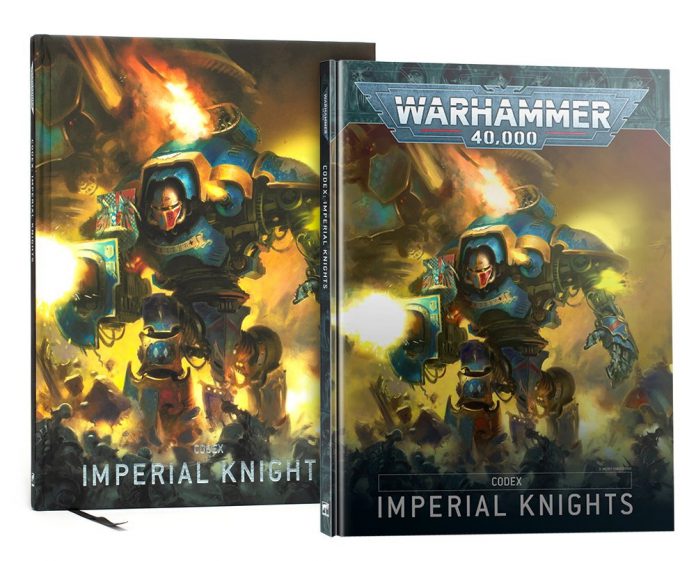Are you a big fan of tales of glorious chivalry, where brave heroes face impossible odds to achieve noble quests? Do you think those tales would be better if the heroes were fifty-foot tall robots? If so, then we’ve got good news for you – the bold champions of the Imperial Knights are mustering for battle once more, ready to face down foes both worthy and unworthy alike with the tools from their new and improved Codex. Swearing portentous oaths under the Code Chivalric, augmenting the capabilities of their Armiger squires with new Bondsmen abilities, and bearing weaponry that’s more lethal than ever, the Imperial Knights are ready for war, and in our review we’ll lay out what to expect.
We’d like to thank Games Workshop for sending us a review copy of this Codex, plus a few of the models you’ll see in this article.
Why Play Imperial Knights?
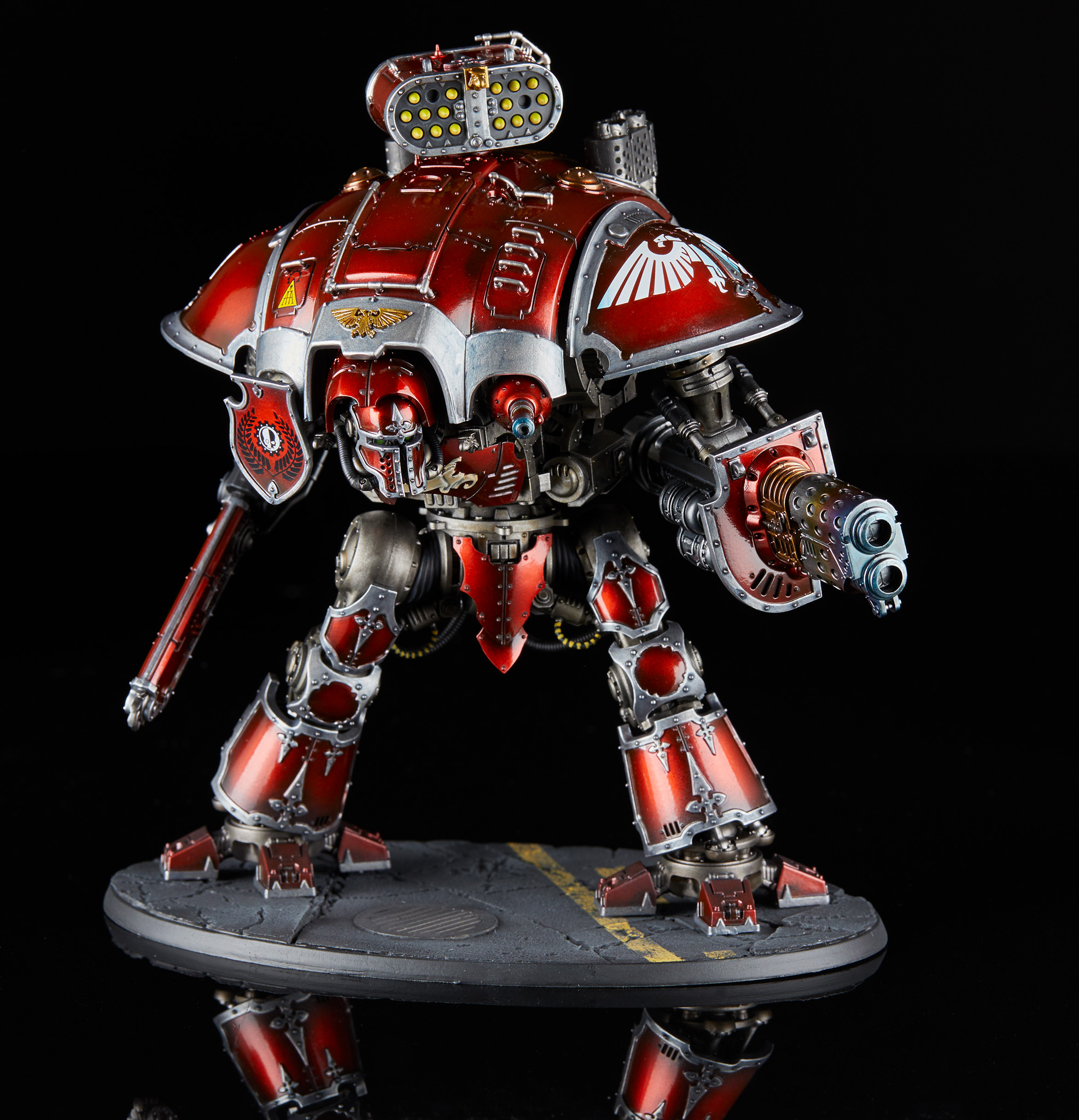
There’s kind of two parts to this question – why play Knights in general, and why use Imperial Knights specifically rather than giving into the lure of the dark side and going with Chaos. Knight armies in general give you a very different play experience to a lot of other factions – you generally have relatively few models (usually 5-7, sometimes more if you’re heavy on Armigers), but even the weakest of them is an engine of war akin to a Marine Dreadnought, and the larger models are some of the most potent in the game. Having fewer models puts the spotlight on each one – every unit in your army needs to pull its weight, and games will be won or lost on based on whether you can maximise each one’s impact.
Learning when to switch between aggressive and cautious postures, how to position your models well, and what risks are worth taking means there’s plenty of skill involved in playing Knights at a high level – but they are also a relatively appealing army for beginners, and can be a great army for players starting out their competitive journey. Every unit in a Knight army is a fundamentally effective one, and their durability tends to limit how quickly opponents can take them off the table. That means that even when you’re losing games, you’re probably getting to play a healthy number of turns, giving you an opportunity to practice things like positioning and target priority. The focus on fewer models also tends to make it easier to see in hindsight when you’ve made a mistake and learn from it, helping build your skills quickly. Finally – the army is relatively easy to put on the table, as you don’t need that many models, always a plus when starting out.
That covers Knights in general, why pick the Imperial side? Both books have a healthy mix of stuff, but as a general rule the Imperial book leans a bit more towards synergies and combos, while the Chaos one is more focused on empowering each individual Knight as an independent force. If you enjoy building a list that combines units to create something that’s more than the sum of its parts, then Imperial Knights may well be for you (especially the Questor Imperialis side of things), while if you just want to create the most terrifying doombot of them all, maybe take a look at our review of the Chaos Knights codex (though the Questor Mechanicus do bring some of this to the table as well). A lot of the rules in the Imperial Knights book also allow your larger Knights to buff Armigers, so if you’re a big fan of Warglaives bounding into battle alongside their masters then this book has plenty for you. Finally, if you want to just go all-in hyper aggressive, getting as much stuff into combat as quickly as possible, the Imperialis options in this book pull that off better than anything in Chaos.
If you’re a seasoned tournament player, of course, you might also just switch between both as the fancy takes you – magnetise some chaos stars and imperial eagles and swap the ornamentation as needed event-to-event. Simple.
What’s in this Book?
- Lore for the Imperial Knights, and their many storied households.
- Rules for constructing an Imperial Knight army, plus the option to bring a Freeblade alongside other Imperial forces.
- The Code Chivalric, a new set of rules providing buffs to your Knights for achieving glorious deeds.
- A new set of Exalted Court upgrades, letting you grant your mightiest Knights new abilities and enhanced buffs for their Armiger squires.
- Rules for nine different Noble Households, plus the first in-codex Army of Renown in the form of the Freeblade Lance.
- Knightly Teachings, allowing your Preceptors to boost your Armigers with words of wisdom.
- All the relics, stratagems, traits and secondary objectives you’d expect from a 9th Edition Codex.
- An especially deep set of Crusade Rules, providing rules for noble quests and very granular Battle Traits and Scars that can be applied both to your pilots and the Knights themselves.
- Datasheets for all the Imperial Knight units.
The Five Best Things About This Book
- Depth: Despite only having a few units to pick from, there’s a huge amount of depth in this book thanks to the wide range of subfactions and upgrades available.
- Bondsman Abilities: Questoris Knights can now hand out powerful buffs to Armigers, meaning your army is especially deadly when it’s working as a team.
- Secondary Objectives: A lack of depth of Secondaries has been holding Knights back all edition, and highly playable choices in both Shadow Operations and Purge the Enemy should ensure they’re no longer scrambling for a third good pick half the time.
- Relics: A spicy selection of relics was one of the big draws to Imperial Knights in 8th Edition, and that’s just as true in the new book.
- Freeblades: The Freeblade Lance looks like it should be fun to use, and the option to bring a Knight alongside other armies without compromising on their special rules opens up plenty of options across the Imperium.
Where’s Crusade?
As always, our narrative team are hard at work preparing a Crusade review for this book, which will be published on Tuesday. Do you like quests? Well you’re going on some, so get used to it.
The Rules
Detachment Abilities
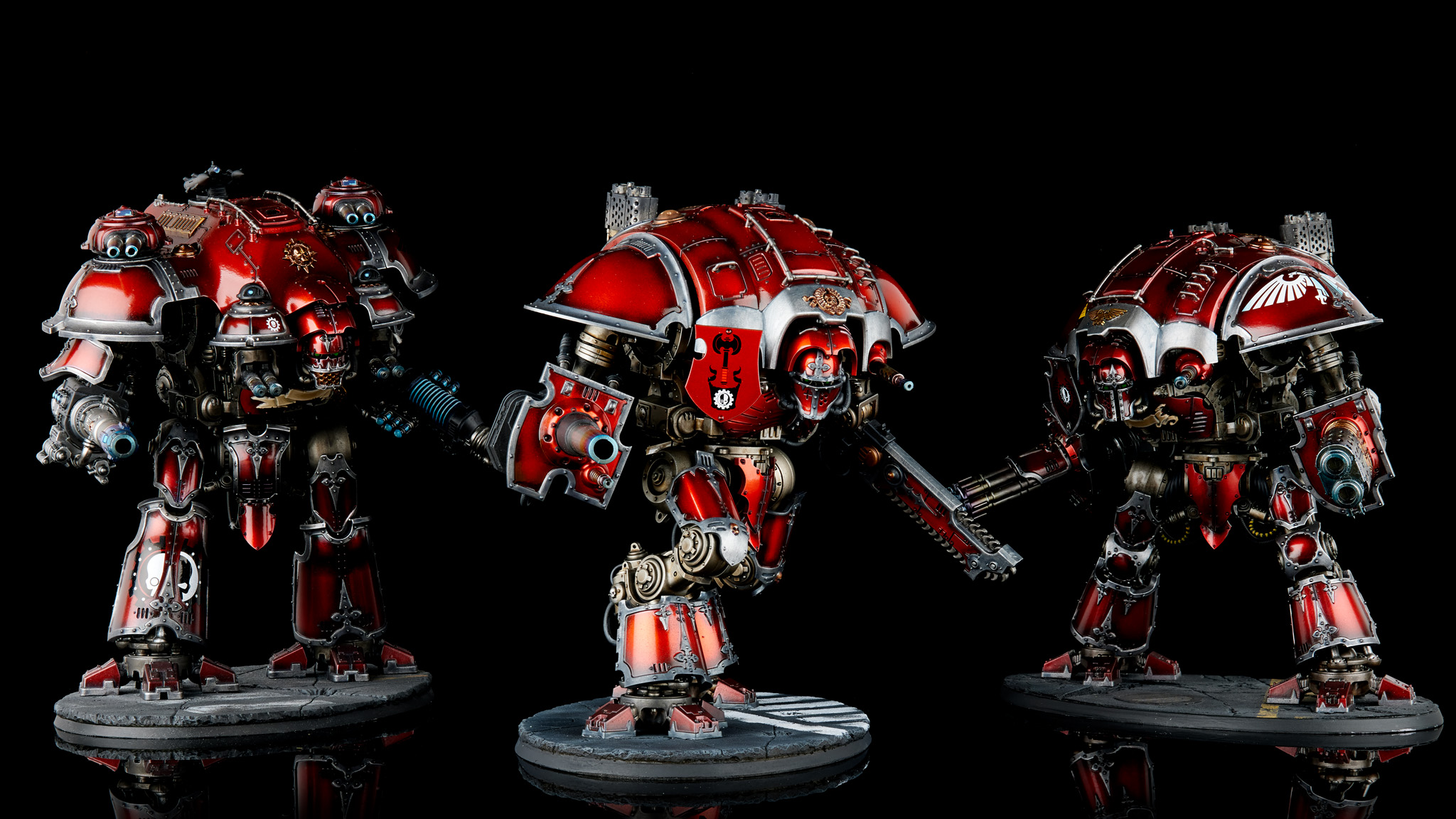
As an army made up entirely of Lords of War, Knights have a fairly unique set of detachment abilities to ensure their lists function as you’d expect.
Up front, Knights get a specific exemption to the general rule that Super Heavy Auxiliary detachments do not qualify for Detachment Abilities – so a solo Knight (or trio of Armigers) will benefit from rules in this section as long as they meet any other criteria. That’s particularly important for Combat Patrol, as without it you’d be running three Armigers with no abilities.
Any Imperial Knight detachment gains a number of abilities discussed below, and any Armigers within the detachment gain Objective Secured (because they’re the closest thing you have to Troops).
Knight Lances
Knight Lances addresses two key issues that Knight armies have – Super Heavy Detachments are expensive, and Knights have no specific “character” datasheets to bring along as their Warlord and hand relics to (other than Canis Rex, but he’s a bit of a special case).
This rule levels the playing field, and will be somewhat familiar to players from 8th Edition (though it has changed a bit). First up, for each Super Heavy Detachment (or your single Super Heavy Auxiliary in Combat Patrol specifically) you get to pick one Armiger-Class, Questoris-Class, or Dominus-Class Knight to be a CHARACTER, which means they can then be your Warlord and be given a relic (other options for this exist in Stratagems, of course).
In addition, depending on the composition of your Super Heavy Detachment, you get a discount on the CP cost (as long as it contains your Warlord). If the detachment contains at least one Questoris Class model or three Armigers, you get 3CP back, while if you have either three Questoris Class models or 6+ Armigers accompanying at least one TITANIC unit, you get the full 6CP refunded.
This is handy, but a bit harsher than the rule as it has been so far in 9th, where just having a TITANIC warlord fully refunded the cost. You will still find that you get the full 6CP refund a lot of the time, but there’s now one specific setup where you might not, which is one Dominus Class Knight (or Cerastus from Forge World), two Questoris and 3-4 Armigers to fill. As a general trend in both this book and the Chaos one, including Dominus class Knights in your list comes with tradeoffs, both costs like these and reduced compatibility with Relics and buffs. This tentatively, feels like a pretty smart piece of design, as it allows the point price tag of the Dominus Knights to stay reasonable, and the balance of Relics to be more precisely tuned, but it does make bringing a Dominus Knight along feel like a weightier choice.
Unyielding Knight
As foretold in the Balance Dataslate, Knights get a huge bonus to objective control – Armigers count as five models for the purposes of controlling objectives in addition to getting ObSec, while TITANIC knights count as ten models. This is super strong, and avoids opponents being able to outplay you on the Primary just by gradually sacrificing ObSec chaff – they have to actually fight back!
Questor Allegiance Oaths and Household Traits

Credit: Pendulin
Imperial Knights get two different replaceable keywords, the <QUESTOR ALLEGIANCE> keyword and <HOUSEHOLD>, and both of these give them a faction trait. Questor Allegiance Oaths are the first of these, applying to models in any Imperial Knight detachment where all Knights have the same allegiance, chosen from QUESTOR IMPERIALIS and QUESTOR MECHANICUS. As well as a trait for your units, the two allegiances get some separate options for relics and stratagems, plus a completely different set of Exalted Court upgrades.
The Questor Allegiance traits are:
- Imperialis enhances aggressive, melee focused strategies with +1” to Advance and Charge rolls, immunity to any penalties on those rolls, and an extra inch of consolidation.
- Mechanicus ups the durability of your knights, helping you play a more calculating, long game. It provides one extra wound to Armigers, two to TITANIC knights, and allows each model to heal one wound each turn.
Each Knight also belongs to a <HOUSEHOLD>, and each <HOUSEHOLD> is locked-in to one of the two allegiances. As long as a detachment has at least three models, and all your Knights are from the same Household across your whole army (which they have to be in Warzone Nachmund anyway) then it becomes a Noble Household detachment, and you get access to a faction trait (called a Household Tradition), Warlord Trait, Stratagem and Relic. There are also five alternative “Martial Traditions” you can pick from for each of the Questor Allegiances if none of the named houses takes your fancy, giving you a trait but nothing else.
Freeblades
All this gets complicated by the existence of FREEBLADES, independent Knights that aren’t part of any Household, but can be included in your detachments. By and large, these don’t break the other rules (with the exception that a Freeblade with the wrong Questor Allegiance in a detachment will break the Oath for other models), but don’t count towards them either. A Freeblade never gains a QUESTOR ALLEGIANCE oath, and doesn’t count as one of the three models in a detachment towards it becoming a Noble Household detachment (but doesn’t stop it becoming one either). Instead, each Freeblade unit in your army independently picks one of the choices from the appropriate Martial Tradition list to apply just to them (even if there are fewer than three Freeblades in the detachment, that limit explicitly doesn’t apply to them). FREEBLADE also acts as a replacement for the HOUSEHOLD keyword on datasheet abilities, so a FREEBLADE can use Bondsman effects on other FREEBLADES (most common in the Freeblade Lance).
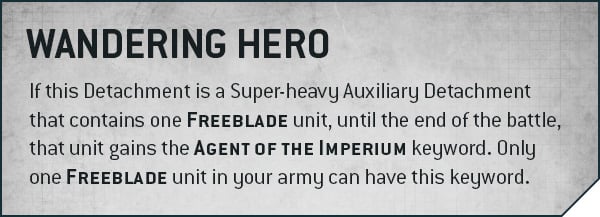
That’s one of two additional options Freeblades get. If you want to build an entire army of storied heroes, united under a single banner, you can use the Freeblade Lance Army of Renown, which we’ll take a look at later. Alternatively, if you play another Imperial faction and think a gigantic robot would improve your chances of victory, you can use the new Wandering Hero rule. This applies to a Super Heavy Auxiliary detachment containing a single FREEBLADE unit, and grants them the AGENT OF THE IMPERIUM keyword, which generally means they won’t break access to army-wide abilities or Secondary objectives. While you’re obviously still going to sacrifice some amount of synergy to do this, there definitely are builds out there that would benefit from a gigantic robot (or three smaller, ObSec ones, this rule is Unit not Model, so an Armiger trio counts), so keep this in mind.
Army-wide Rules
Code Chivalric
The Code Chivalric is Imperial Knights new army-wide monofaction ability, applying to all your units as long as your list is purely made up of Knights from the same Household, Freeblades and Agents of the Imperium. It provides army-wide boosts that can improve if you achieve noble deeds, or vanish if you fall into dishonour.
How it Works
When writing your army list (note that it is at list time, not pre-battle) you pick two out of four available oaths, each of which has four parts:
- A Pledge – a condition to meet to uphold the Oath.
- A Troth – conditions that represent you failing to uphold the Oath.
- An Honoured ability, a buff that’s available when you’re doing OK at being honourable.
- A Virtuous ability, a additional buff you unlock by being extremely honourable.
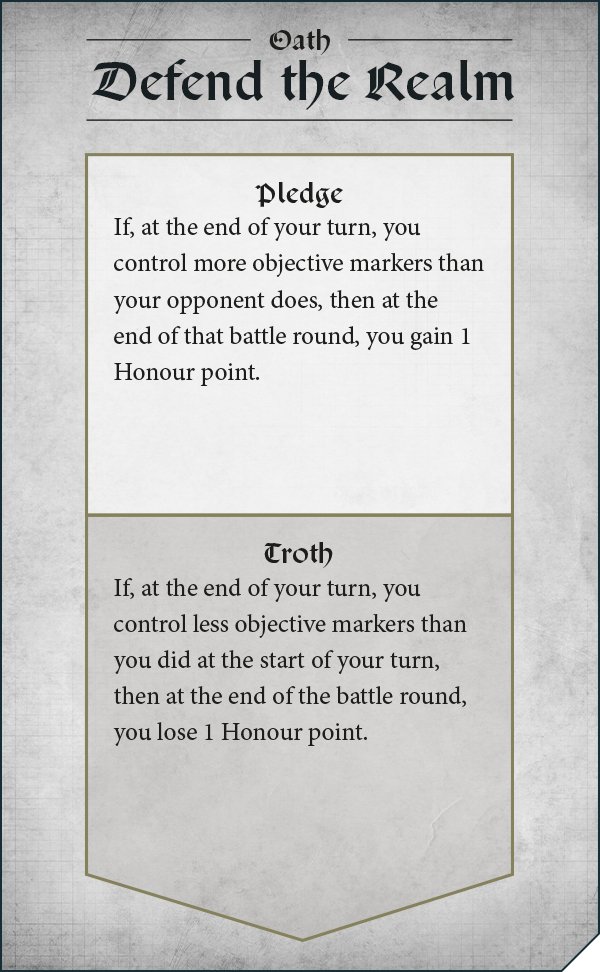
You start each battle with one Honour point (increasable with a few upgrades in the book), and at the end of each battle round you gain one for each Pledge you met, and lose one for each Troth you triggered (your total cannot decrease below zero or increase above six). Finally, at the start of each battle round you determine if your army is Dishonoured (zero Honour, just shameful), Honoured (1-4 Honour) or Virtuous (5-6 Honour), and switch on either the Honoured abilities or both the Honoured and Virtuous abilities of your Oaths for that round as appropriate. While you have two different Oaths, you have a single honour score, so if you’re failing to achieve heroic deeds on one front, you can at least tread water by being glorious on another.
The Oaths
The four Oaths you can select from all have suitably portentous names, which roughly line up with their rules.
First up we have Protect Those in Need, all about ensuring that your Knights don’t refuse an opportunity to get stuck into a glorious combat. The Honour gain and loss mechanics here directly mirror one another. You get a point if you either perform a Heroic Intervention or make a charge against an enemy unit that was already in engagement range of another of your units at the start of the phase (i.e. you get stuck in to help out an ally). If you could do either of these things and choose not to, you lose a point. This does mean you can both gain and lose a point in the same turn here, which is not actually a bad thing, because our impression is that a lot of the time your goal is going to be to just stay stable in Honoured. Speaking of Honoured, the bonus for being at that level here is that all your units can Heroically intervene, and your CHARACTERS can intervene 6”. That gives you lots of opportunities to earn a point, but also allows your opponent to potentially knock a point off by putting something extremely dangerous near to one of your Armigers. The Virtuous ability here isn’t massively inspiring here though – it just lets you use your Bondsman abilities one additional time. Realistically, if you’re building around those you’re very likely already packing ways to use them multiple times, and by the time you can become Virtuous, you’re likely going to be missing a few models, so it won’t do that much.
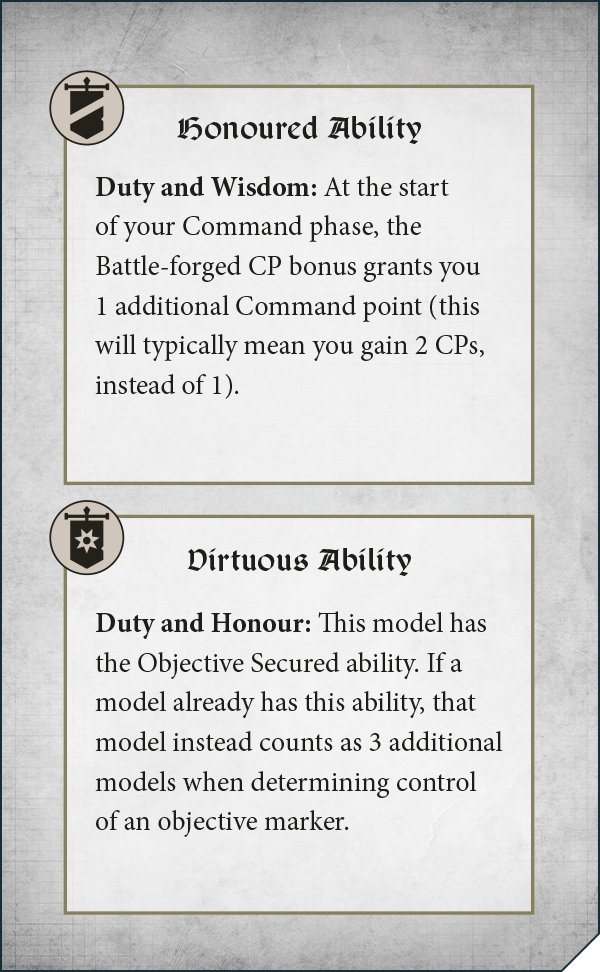
Defend the Realm is next, and very good. You gain a point here by controlling more objectives at the end of your turn than the opponent, which will nearly always be something you’re planning to do anyway. Losing a point is also hard here too – to trigger the Troth, you have to control fewer objectives at the end of your turn than the start, and the natural flow of how the game goes means this will rarely happen unless you’re already out of contention. Both rewards here are also great – the Honoured ability doubles the Battle Forced CP bonus at the start of the turn (which is just always something you want as Knights), and the Virtuous ability provides army-wide ObSec (or upgrades any models that already had ObSec to count as three more extra models). Great stuff.
Note: The Honoured ability here is an oddity in that it’s clearly army-level, but almost all abilities in this book that interact with the Code Chivalric are written in a way that assumes all bonuses from Oaths are all evaluated at a unit level. This raises the question as to what happens with this if, for example, you have a unit in your army with an effect that ensures they never count as Dishonoured – do you get the CP bonus here even when your army is Dishonoured as long as one unit has that ability? For evaluating everything else I’ve assumed the answer is no and that you have to be Honoured on an army level for this to count, but keep an eye on what the FAQ does for this.
Next up, Refuse No Challenge has a very flashy Honoured ability, giving you +1 to hit in the first round of combat. All Knight armies will need to make use of the Fight Phase to get stuff done, so this ranges from good to exceptional depending on how hard you build for it. It also rewards you for getting into melee – the Pledge here is for you to destroy two enemy units with melee attacks in during a Battle Round, which is definitely something you want to be doing in the mid game. However, you might find yourself triggering the Troth pretty often as well – you lose a point if any of your units fall back in a Battle Round, and since TITANIC Knights can do so with effectively no penalty, you’d normally do so quite often. Again, that doesn’t massively matter here as long as you can stay stable in Honoured – the Virtuous ability is re-roll Advances and Charges, which is fine but not required.
Finally, Lay Low the Tyrants has the challenge of the easiest Troth to fail, but a big upside. The Troth triggers if you fail to destroy at least two enemy units in a Battle Round, and bluntly if you go first in many games this will happen. That requires you to build your list around this a bit (usually by bringing one of the abilities that causes you to start on two Honour rather than one), but the payoff is pretty big, and once the game is in flow triggering the Pledge isn’t too hard. The Honoured ability here is one re-roll of a hit or wound roll each time one of your units Shoots or Fights – we’ve seen this lots, and it’s always great. The Virtuous ability is also very good – once per Battle Round (across your whole army, which means this isn’t totally game breaking) you can change a hit, wound or save to be a 6 after rolling, which is extremely useful (especially for a save). Even better, as long as you can start the game rolling, the Pledge isn’t too hard to achieve – an Honour point as long as you destroy a VEHICLE, MONSTER or CHARACTER (or your opponents Warlord if they’re somehow none of those).
Impact
I’m a bit conflicted on this mechanic – it’s powerful and going to be a real asset for Knight lists, but I think you’re often not going to fully engage with the goal of becoming Virtuous. You have to select these on your army list, and sometimes you’re going to find yourself in matchups or situations where landing the Pledge or avoiding the Troth just isn’t really fully under your control. However, that kind of doesn’t matter – the biggest payoff here is the Honoured abilities of Defend the Realm, Refuse No Challenge and Lay Low the Tyrants – so the game instead becomes building your list and selecting these so that you can at least stay stable at one Honour, and if you occasionally become Virtuous then great.
I think that you’ll overwhelmingly do one of two things:
- Pick Defend the Realm and Refuse No Challenge in a melee-focused army.
- Pick Defend the Realm and Lay Low the Tyrants in a more all-rounder build, bringing one of the +1 Honour effects along.
Defend the Realm has a whole host of advantages – it gives you immediate value at the start of your first turn, it’s very easy to score the Pledge if you go first, and very hard to trigger the Troth. That maximises your chance of maintaining your Honour even if your opponent’s list or strategy works against you.
To reap the reward of doing that, you pair it with one of the other two effects that act as a huge force multiplier. You can build lists with this book that get a lot of units into melee at high speed, so Refuse No Challenge can be a big boon. Lay Low the Tyrants is also always going to be good, but comes with a risk – you have the highest change of failing it both early on or if you have an underwhelming turn mid-game. With that in mind, when picking this option it might be sensible to invest in either the Banner of Macharius Triumphant Relic or Revered Knight Warlord Trait so that you start on two Honour, giving you a healthy buffer to work with.
It feels like a bit of a miss that the incentive here is going to be, quite a lot of the time, just to avoid screwing up rather than really leaning in to glory and virtue, but the power as long as you do that is undeniable. As long as you stay Honoured, you functionally get an extra CP a turn and a bonus faction trait, and what army is going to complain about that?
Bondsman Abilities
Bondsman abilities are new Command Phase effects allowing your Questoris Class Knights to buff your Armigers. Each of the five Questoris classes other than the Preceptor gets a Bondsman effect that they can apply to one Armiger within 9” in your Command Phase, providing two things:
- A buff that lasts until your next Command Phase.
- -1 to incoming damage as long as your army is Honoured or Virtuous. This is just thrown in there as an aside at the end of the general rules for Bondsman Abilities, no big deal or anything, Damage Reduction has never been a superstar ability at all.

Each Armiger can only be under the effect of one Bondsman ability at once (if you apply a second one, it overwrites the first).
All five buffs are pretty good – you have three good force multipliers in the form of +1 to either BS or WS from the Crusader or Gallant, re-roll 1s on hits and wound from the Paladin. More esoteric is the Warden’s, upgrading the Armiger to count as ten models for objectives rather than five, definitely good, but the Errant’s is likely to be the biggest game changer. This provides the Armiger with the ability to Advance and Charge and +1” to both rolls.

This would be great if you could just use it to fire one Armiger at your opponents, but as we’ll see when we go into Exalted Court upgrades and the Preceptor’s Knightly Teachings, there are quite a few ways to get multiple uses out of your Bondsman abilities (and additional payoff for using them).
Just at baseline though, if these did nothing other than provide Damage Reduction, you’d still want to have all your Armigers under the effect of one all the time. Given they provide considerably more than that, make sure you build your army so that you can make this happen (which is, as we’ll see, very doable).
The only thing to watch out for here is that these do get applied in your Command Phase, so if you go second and your opponent either gets a bead on your Armigers, or has the damage to take out a Questoris Knight you’re planning to use to apply these in bulk, you could be in trouble. Hiding your Armigers is usually possible on most tournament tables, but against some opponents protecting a Questoris Knight may be challenging (since they can’t be Obscured). The best advice there is to consider having a backup plan for handing these out in the case that your main combo gets shut down.
Unit Abilities
Two abilities are common to a lot of units:
- Ion Shields means that every Knight has a 5+ invulnerable save against shooting attacks.
- Super-Heavy Walker means that all TITANIC Knights can Fall Back and Charge ( and remember they get Fall Back and Shoot just from being TITANIC), and can also move over non-VEHICLE/MONSTER units.
Ion Shields is vital for keeping your units in the game in the face of enemy shooting, and Super-Heavy Walker makes it harder for opponents to bog your Knights down with chaff (though do note – most Questoris units got a bit slower in this book, so clearing the opponent’s models can be a challenge).
Noble Households
Imperial Knights get the most subfactions of any force in the game other than Marines, with a mighty nine named Households, five from the Questor Imperialis and four from the Questor Mechanicus. As standard, these give you a faction trait (here a Household Tradition) and an extra option for your Warlord Trait and Relic, plus a Stratagem. If none of the named houses take your fancy, there are also some extra options for Partial Traditions, five for each of the two Allegiances, which you can pick one of for your army trait, and also form the list from which Freeblades get to pick their trait. Finally, Freeblades get four additional options just for them, ensuring that even if you take lots of them, you’re not going to run out.
With so many subfactions, we’re not going to go as deep on all of these as we normally would, but we’ll highlight the standouts in each half.
Questor Imperialis
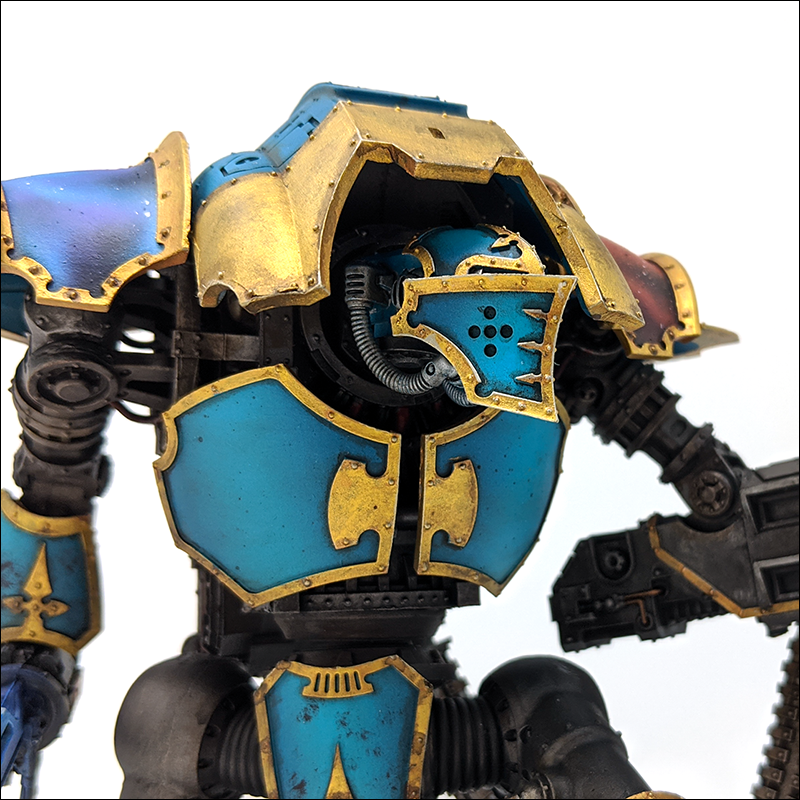
Questor Imperialis is generally skewed towards aggression and melee combat, and with that in mind the big, big winners here are House Griffith. Their Household Tradition gives them +1A in the first round of combat, now even when they get Charged, and that’s strong stuff – the baseline nastiness of Knights build for melee has increased quite a bit (especially in combination with Refuse No Challenge), so this rules. It also goes extremely well with their Warlord Trait, which is just straight up Advance and Charge all the time for the Warlord. The Full Tilt stratagem no longer provides this, so if you want to go for Maximum Gallantry, this is now your angle. Their Dragonslayer stratagem is also improved – it’s still +1 to wound when Shooting or Fighting, but now keys off VEHICLE or MONSTER rather than 10+ wounds, giving it far broader utility to blow away mid-range units. The Relic is kind of whatever, Mortals on charge, but everything else here pulls hard in the right direction, and looks like a very strong choice.
The rest of the Imperialis Houses have big draws as follows:
- House Terryn’s stratagem, Glory In Honour, allows one of their knights to be even nastier than a Griffith one in fight phase, gaining +1A and re-roll 1s to hit. They also get boosts to their Advances and Charges, but maybe too many
- House Cadmus are great at clearing hordes, with melee wound re-rolls of 1 against non-VEHICLE/MONSTER targets, improving to full re-rolls against big units. Their Warlord Trait also keeps the flashy -1D in melee, which generally feels more impactful now that any Armigers riding shotgun will probably also be packing it.
- House Hawkshroud get a bit of tuning – as well as their Knights counting as having double wounds remaining for their profiles, their models also now count your honour total as one higher (as long as you’re not dishonoured), making aiming for the Virtuous abilities a bit more practical. The Angel’s Grace relic is now an anti-Mortal aura on 5+ for Armigers (and the bearer), which is pretty neat in the current metagame as well. Finally, their Staunch Allies stratagem, letting one of them get involved in a nearby combat, has been changed to drop the ability to fire Overwatch but add an improved version of the “super heroic” – the Knight performing it now moves 6”+d6” rather than 2d6”, and gets to Fight First in the subsequent phase. That means that getting into a fight near a melee-focused Hawkshroud Knight is extremely unsafe.
- House Mortan get generally improved across the board, and plausibly end up as a sleeper choice as a result. Their Household Trait is now an always-on re-roll 1s to hit in melee, which on paper is worse than their old +1 to hit but because it stacks with Refuse No Challenge ends up as better – as long as you stay Honoured, you get to enjoy a 97% baseline melee hit rate. Their relic reaper chainsword, Honour’s Bite, is substantially better now too – these weapons in general get a sweep mode, so a weapon that triggers mortals on 6s (one on the sweep, upgraded to flat three on the big swings) is just generally more useful. Finally, Slayer of Shadows for dealing with all of those pesty elves and their hit modifiers now works in melee too and also protects you from WS and BS modifiers, a flat upgrade.
Questor Mechanicus

The Questor Mechanicus curve is a bit flatter than Imperialis, with all of Raven, Taranis and Krast looking pretty interesting, and maybe only House Vulker falling behind.
Raven remains an excellent choice for those that like to shoot on the move – they can Advance and Shoot at full effect, and now also get to ignore move and Advance penalties while doing so. Knights have lost a couple of inches of movement across the board, so if you play on tables with lots of difficult terrain this can really help. Order of Companions gets a complete re-work too, but remains excellent. Rather than a boost for a unit when it shoots, this is now a pre-game upgrade you can use on two of your Knights (in Strike Force) for 1CP each that gives them a re-roll for hit, wound or damage each time they shoot or fight. Bluntly, this is amazing, and I cannot imagine running a Raven list where you don’t add this to two of your big Knights. The Banner Inviolate is also side-graded in a way that some lists can certainly maximise – it now provides a re-roll 1s to hit Aura for Armigers only, but works in both Shooting and Fighting. Finally, it’s a little unclear whether the House Raven supplement counts as “superseded by a Codex” when this book lands, but if it doesn’t then the extra durability in melee provided by Crimson Wall is very powerful too.
Taranis was consistently one of the strongest Households in the old book, and the good news is that their powerful Tradition remains – 6+ to ignore wounds against everything except Mortals. Knights are an army where one model holding on by the skin of their teeth can be game changing, so this rules, as ever. The rest of the kit is strong as well – Our Darkest Hour allows a Knight to get up from destruction on a 4+, and while it’s once per game it’s gotten cheaper, so you reliably get to make your opponent squirm as they wait for the dice roll. Their Warlord Trait, Knight of Mars is also now very flashy. This gives you the ability to, once per game, substitute in an automatic six after rolling a hit, wound, save, damage or charge roll and making any re-rolls. This kicks ass just on baseline, and the even better bit is that if you manage to become Virtuous it switches to once per turn, rather than once per battle, massively rewarding you for pulling that off. Having a clutch unfailable save in the pocket for when it really matters whips, and this also has a specific combo with the new Calculated Targeting stratagem to automatically drop a big pile of Mortal Wounds on an enemy. It’s unclear whether the price on that makes this more of a meme than an actually good plan, but the idea of tapping an opponent with a volcano lance then turning the damage into Mortals is extremely appealing.
House Krast have, sadly, caught the baleful eye of the balance gods and had their Household Tradition toned down – they now auto-wound on 6s to hit in melee rather than re-rolling hits in the first round of combat, which is fine but definitely weaker. The rest of their kit is still strong though, leaving them as a pretty appealing house. The Controlled Aggression stratagem is another way of providing Knights with +1A in combat, and has the strong gimmick that you can choose to apply it to two Armigers rather than one big Knight. First Knight creates a powerful melee killer – your Warlord’s WS gets boosted by one, and they also get to benefit from one of your chosen Virtuous abilities whenever your army is Honoured, selecting one in each of your Command Phases. This is incredibly good with either the ObSec from Defend the Realm or the auto-6s from Lay Low the Tyrands, making this a very good trait. Finally, the Headsman’s Mark is arguably surprising in being better than ever, now giving you +1D against all VEHICLES and MONSTERS (rather than only those with 10+ wounds) and adding +1 to wound against TITANIC targets rather than a second +1D, a reasonable trade to pay for the broader base effect. One or two big Knights with lots of Armigers looks like a promising build, and Krast certainly have the technology to pull that off.
Finally, Vulker’s kit isn’t bad exactly, but not lifting you up as much of the rest here – you get some modest boosts to shooting from the Tradition and Stratagem and an OK Warlord Trait, but nothing like the consistent spice the rest give you.
Custom Households
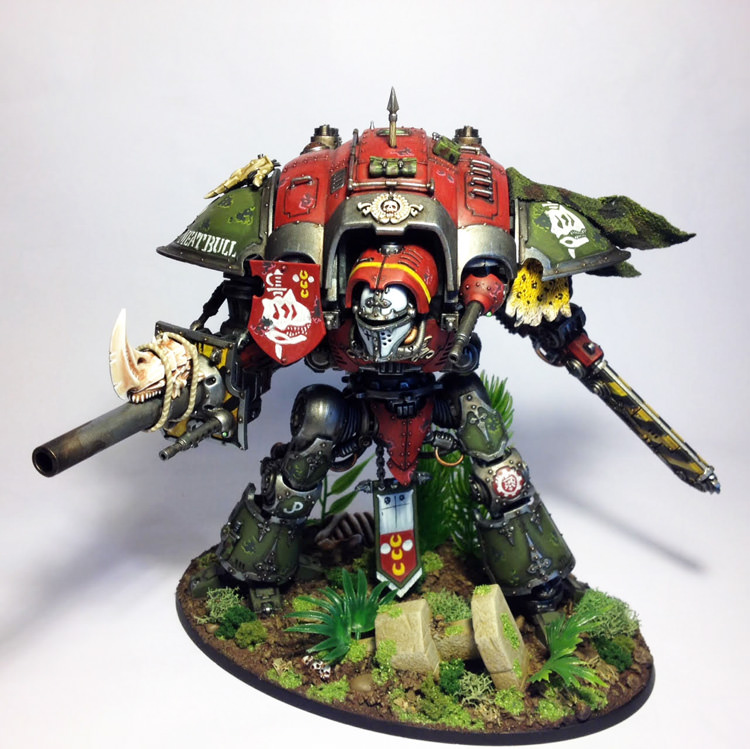
In addition to the named houses, you get five choices each for alternative Martial Traditions for Questor Imperialis and Mechanicus, plus four for Freeblades only. If you don’t like any of the named Households, you can pick one of these instead of them, and each Freeblade unit individually pics one off the relevant list for their Questor Allegiance or the Freeblade selection. Finally, each of the two Questor Traditions also has a sixth pick for the now standard “named Household, but with serial numbers filed off” option, but these can’t be taken by Freeblades and are slightly less good than just being the Household, so they’re strictly for very narrative play.
On the Imperialis Side, there’s some choices that are at least intriguing. Hunters of Beasts provides massive boosts against enemy VEHICLE and MONSTER units, and even more massive ones against enemy TITANIC stuff, so if Imperial and Chaos Knights between them carve out a big part of the metagame this could be a real pick. Strike and Shield is a more broad effect, providing Transhuman for hit rolls in melee, and also allowing Knights to reduce AP-1 to 0 against melee attacks, helping brutally bully armies like Orks using volume AP-1 to overwhelm you.
Two of the others here have some niche interest. Paragons of Honour gives all models with the trait a whole extra oath to play with, which gives you both the option of going army-wide wild with all of Defend the Realm, Refuse No Challenge and Lay Low the Tyrants, or being a bit sneaky and using an embedded Freeblade to help generate Honour. Paragons says that the Troth and Pledge of the extra Oath only applies to the model with it, and while it’s frankly a little unclear how you evaluate that for some of them, Protect Those in Need is pretty clean, giving your Freeblade the ability to Heroic and some Honour for your army when they do, without the risk of the opponent triggering the troth by baiting units that don’t want a fight.
Finally, Noble Combatants is one where we think there might be a key typo in the rule, and it’s pretty strong if that gets fixed. The ability essentially gives all your Knights Competitive Edge in a fight (retry any attack that misses, fails to wound or gets saved on the first attempt), which is wild…but it excludes attacks made with a Sweep or Strike profile. Which is, uh, all profiles in the book except for titanic feet, which doesn’t fit the fluff description at all. The clue here is that a later part of the ability prevents you making any additional attacks generated with Sweep or Smash profiles (Smash being the Sweep of some of the Forge World Knights) so we think there’s a good chance that this is supposed to be the rider on the first part too. If that is the case, this is pretty eye-popping for Warglaive heavy builds, and also brutal on the tempest warblade of the Forge World Knight Castigator, which could make for a neat Freeblade (though we expect a pretty thorough errata pass on the Forge World Knights in general to align with this new book, so don’t 100% rely on that staying).
Questor Mechanicus get two highlights and three options that are honestly kind of bad. The big ones are Honoured Sacristans on the defence and Machine Focus on attack. Sacristans improves your armour saves by 1 against D1 attacks, and given that the Asuryani are very big on chipping stuff down with D1 output right now that can certainly matter. Machine Focus, meanwhile, provides the boring but effective boost of one re-roll for wound or damage each time the model shoots, strong on an army that wants to operate at range. Only Blessed Arms out of the rest, boosting range and enhancing stubbers, looks semi-OK, and even that isn’t really needed.
Finally, Freeblade-specific choices, where three out of the four seem interesting. Mysterious Guardian allows the Freeblade, if placed into Strategic Reserves, to arrive as if it was a turn later than it actually was, so coming in on a flank right out of the gate is permissible. Potentially good on both a big Knight and Armigers. Peerless Warrior, meanwhile, gives a once-per-game free use of an Epic Deed, which is probably either Valiant Last Stand or Machine Spirit Resurgent depending on your Questor oath. If you’re building a Freeblade Lance, this seems fine to throw on a Knight you want to be aggressive with. Finally, Mythic Hero lets the Knight count your current Honour as two higher than it actually is. Notably, unlike most of the other effects like this in the book this doesn’t switch off if you become Dishonoured, so the relevant model will always have your Honoured effects, and a way easier time jumping to Virtuous. This definitely feels worth a look with that in mind.
Stratagems
There’s a lot of depth in the Stratagem sheet here, and quite a few new effects compared to the previous edition. Most notably, there’s a tonne of stuff in here that boosts Armigers in various ways, further encouraging you to build an army that mixes them up with big Knights.
Prior to diving into the new stuff, let’s take a quick look at key Stratagems from the old book that either have or haven’t made it into 9th Edition.The big ones that still work much the same are Rotate Ion Shields (boosting a shooting invuln to 4+) as your key defensive choice and Machine Spirit Resurgent (act on full) for the Mechanicus – both now cost 2CP for Questoris or bigger Knights (which is actually a buff for Rotate on a Dominus), but you’ll still want to use them a lot. Noble Sacrifice (increased chance to explode) also returns on the same theme, tweaked in a way that probably ends up as net better. You can now only use it once per game, but now guarantee exploding when you do, which is a big old problem for opponents who need to gank a big Knight. The two previously key stratagems that are probably less broadly useful (or at least need more work now) are Full Tilt and Valiant Last Stand. Full Tilt is now an automatic 6” Advance (or 9” for an Armiger), which is generally less useful than the old Advance/Charge except when combined with the Errant’s Bondsman ability, at which point you’re firing an Armiger at the enemy at speeds previously unknown to robotkind, which is pretty cool. Valiant Last Stand, finally for this bit, is just the standard 9th Edition FIght on Death if you haven’t already fought, which is fine (and has the decency to cost 1CP on an Armiger), but not as splashy as the old version that could let you shoot.
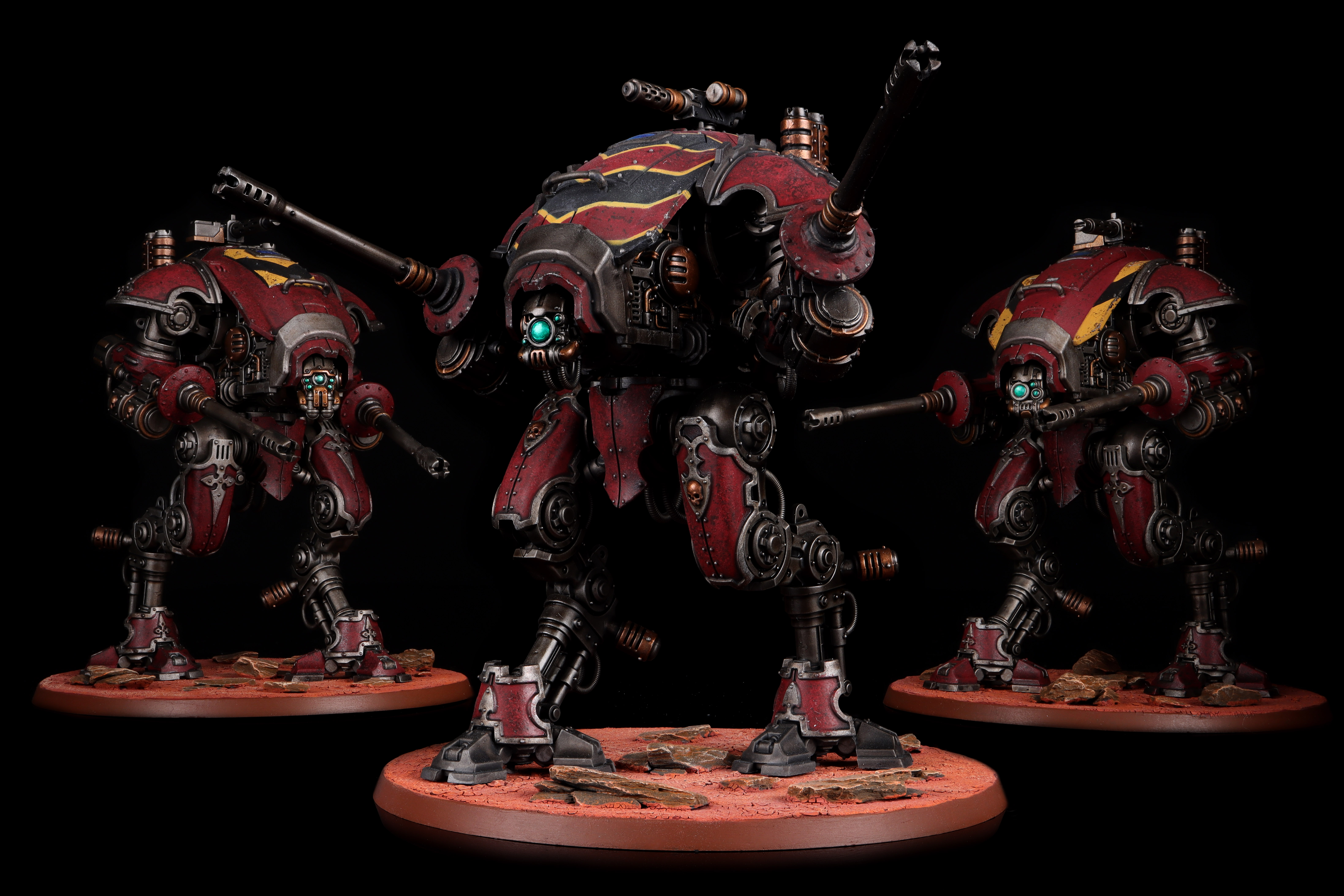
Credit: Pendulin
Moving on from that, there are a lot more Stratagems here than there used to be, and a big chunk of that is because Armigers can access a truly spectacular range of situational buffs.. We’re honestly not going to try and list all of these – most of the common flavours of short term efficiency, defensive or mobility buff are here in some form or another, so just be aware when playing with or against Armigers that as long as there are CP in play, they’re extra flexible. One more unusual trick to pull out is Flanking Manoeuvres, which for 1CP can put two Armigers who are within 6” of a table edge into Strategic Reserves at the start of your Movement Phase (they can’t arrive on the same turn). This rules – 1CP is less than it would cost to put two Armigers into Reserves anyway, and is a powerful way to adapt to who gets the first turn. On a tournament table with good terrain, you probably want the armigers on the table to counterattack into your opponent if they go first, but if you go first they might not have any good targets. Making sure that you deploy two of your robots so their bases are a hair within 6” of the table edge means that if you go first you can pull them into Reserves for later use, massively boosting their utility. Very cool. The other rare effect Armigers get is borrowed from Necrons in Defiant Fury. When one of your CHARACTERs dies, one of your Armigers can get real mad about it, shooting at the culprit at the end of the phase and getting full hit re-rolls against them for the rest of the battle. This is, frankly, vastly scarier than when a Canoptek Doomstalker does it, and a very useful way of ensuring you don’t fall badly behind when you lose a big model.
Moving up to broader stuff, both Questor Allegiances get an additional splashy trick they can use. Linebreaker moves from being a Gallant-only stratagem to a general trick for Questor Imperialis, allowing a model to Consolidate 7” in any direction (as long as you either end up in Engagement Range of something or at least 3” closer to the opposing board edge), providing a wide variety of ways to cause problems on purpose. You could reach out and tag something that the opponent was sure was safely out of the way, or you can use it to put some attacks into a hyper-deadly target then Consolidate out of harm’s way before they can swing back. In line with the general split, Questor Mechanicus get a shooting-focused stratagem and oh boy, is this one a heartbreaker. Calculated Targeting is very expensive (2CP for Armiger, 3CP for Questoris, 4CP for Dominus) but arguably one of the swingiest abilities GW have ever printed, at least in context. You use it when you shoot, and it means that any unmodified 6s to wound become instant Mortals equal to the damage characteristic. Now look – yes 4CP to pop this on a Castellan is a massive investment – but if you have to turn a game around, is the chance of just melting the opponent maybe worth it? Don’t forget that there are multiple ways to get an automatic 6 to wound in the book (between Taranis and Oaths), as the high CP spend becomes more palatable if you’re certain that it’s going to involve someone taking a massive knock. While less outright flashy, 2CP to chuck this on an Armiger Helverin or lightning lock-toting Moirax is also not too bad of a rate, and this is also a prime candidate for the once-per-game free Battle Tactic on an Armiger that Master Tactician provides. Finally, both Allegiances benefit from a very useful generic tool in Martial Prowess, allowing a Knight to add +1 to armour saves when chosen as the target of an attack in the Fight Phase. This mitigates the lack of an invulnerable save in melee, as it gets you to a healthy 4+ against the common AP-2 profiles, and gives you a fighting chance against nastier stuff.
Beyond that, you have a fairly predictable suite of stuff to round things out – standard 9th Edition upgrade Stratagems plus the spicy double Warlord Trait special (for your actual Warlord) on top, some boosts to each of your different melee weapons (with both titanic feet and the paragon gauntlet getting some ways to bypass defences at a cost of a bit of risk), and an equivalent of the “automatic litany” stratagem for Preceptors (at a bargain 1CP price). One final note on that lot – giving a Relic to a Knight no longer makes them a CHARACTER, but they also don’t need to be a CHARACTER to be given one (adding a Trait still adds the CHARACTER keyword as well).
You’ve got a lot to work with overall, and while losing all-purpose Advance/Charge is a bit of a blow, there’s plenty of power here for Armigers in particular to make up for it.
Warlord Traits
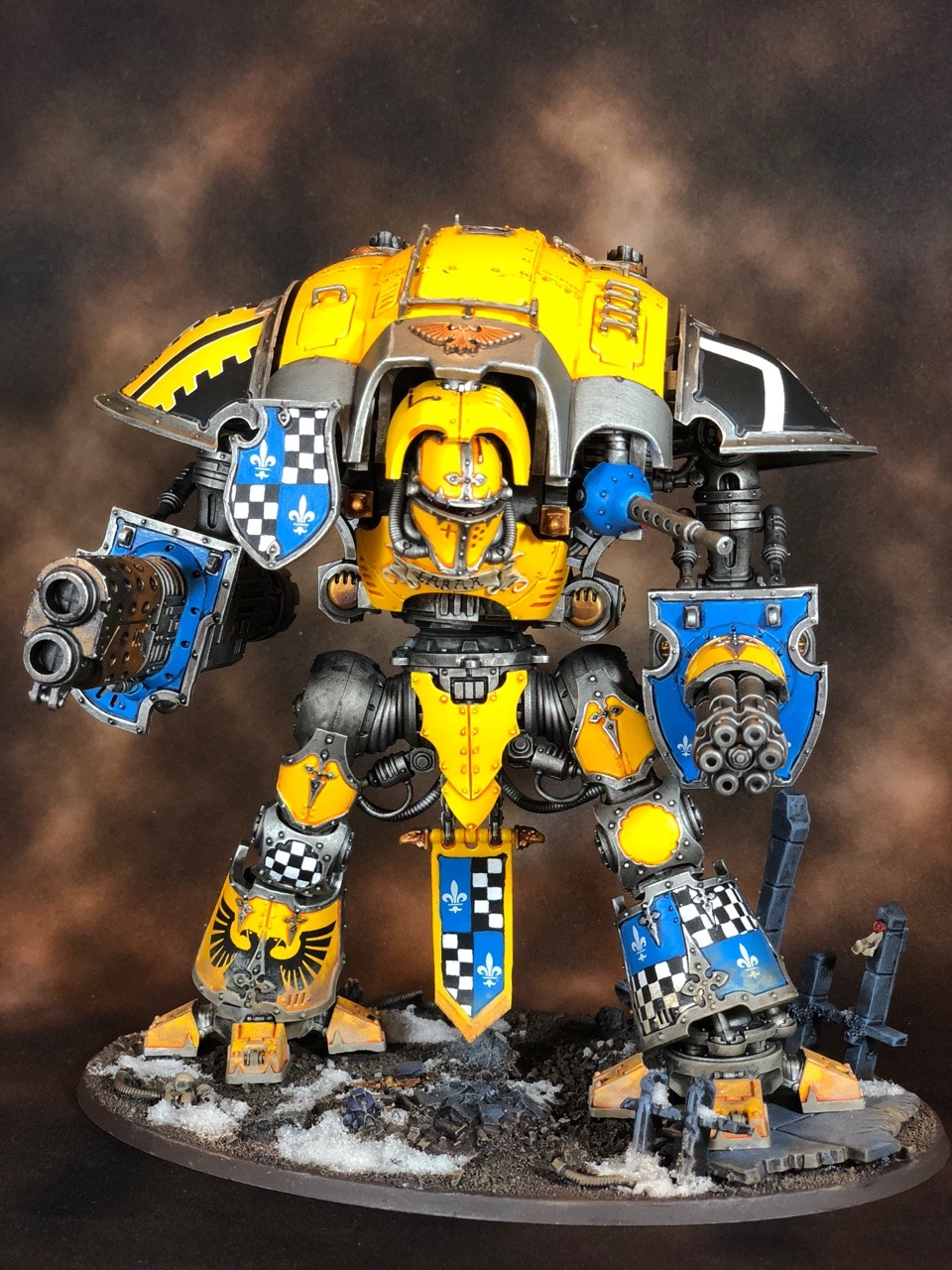
As standard, Knights get six generic Warlord Traits to choose from, and the good news is that none are bad. It’s fair to say that the old stalwart of Ion Bulwark (permanent 4+ invuln against shooting) is still going to be your first pick a lot of the time, as the value on it is huge, and it’s great for protection the source of any Bondsman combos you want to build. However, both Knight Seneschal and Revered Knight are frequently going to be competing for your attention. Knight Seneschal provides a flat +1A, and also means that the Warlord still gets the Honoured abilities of your Oaths when the army is Dishonoured. If you’re picking Refuse No Challenge that ensures that this Warlord is on effective WS2+ with 5A all the time, which is obviously great! Revered Knight also keys into the Code Chivalric by allowing you to start on two honour rather than one (at the cost that if the Warlord dies, you lose an Honour point). This can be very helpful if you’re taking the higher risk, higher reward choice of Lay Low the Tyrants, and comes with the extra bonus of Fight First as well.
While those three feel like the likely common picks, there are uses for two of the the others too. Blessed by the Sacristans gives you a Mortal Wound on all 6s to wound when shooting, which can certainly add up over a game (and feels like the sort of thing that’s worth adding as a double pick with Revered Paragon), while Landstrider makes you go very fast – it boosts your move by 2”, and means you treat Advance or Charge dice of less than three as three. This is another good one to double up – especially if you’re House Griffith and taking Master of the Joust for Advance/Charge. The final option here is maybe the one that won’t come up much – Cunning Commander provides a CP in your command phase on a 5+, and that’s a bad rate – you’re going to lose some Knights sometimes, and the risk that this does very little for you is pretty high, so it’s not going to be worth adding with a CP. With plenty of good options, that’s at least not the end of the world!
Relics
Relics are a place where there’s very much a sense of a pendulum swinging. One general note – other than the two gun choices that specifically upgrade Dominus weapons, all of these Relics are now Questoris or Armiger only – so Dominus Knights can’t take some of the defensive upgrades.
Let’s start with where things feel a bit weaker – guns. One of the defining features of Knights in 8th was how good some of their relic guns were, and that’s a lot less true now – the relic guns are still generally better than their regular versions, but the regular versions have often improved a bit, and the margin is way less dramatic. The exception to this is the Judgement upgrade for a stormspear rocket pod, which changes the damage from d6 to 3+d3 and allows the weapon to fire indirectly when it normally can’t. Even with the new Indirect Fire rule, yes please!
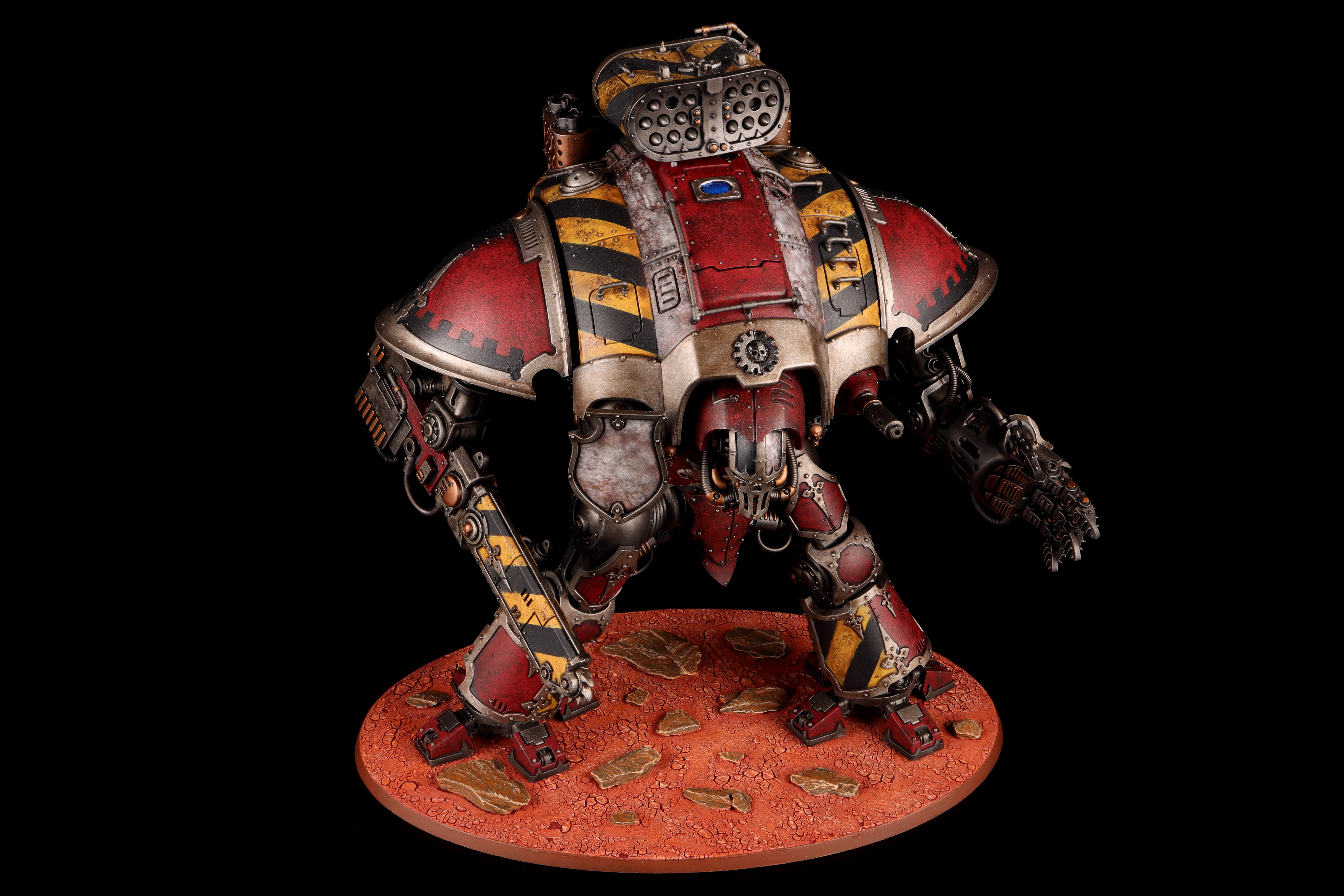
Credit: Pendulin
OK, so the guns are a bit less of a draw – not great. However, savvy players who’ve been using Knights in 9th will know that even though the book hasn’t changed, which relics are good in the metagame has, and players have much more commonly been using defensive tools like The Armour of Sainted Ion and Sanctuary to keep their Knights in the game longer. Great news – Sainted Ion is unchanged (2+ base save) and Sanctuary got better (4+ invulnerable save in the Fight Phase). Both still really strong picks that you’ll see in a whole bunch of lists. Potentially joining them more often are the signature melee relics, Ravager and the Paragon Gauntlet. These benefit from the fact that Sweep profiles are now part of the melee weapons, making them very flexible. Ravager comes with exploding 6s to hit and improved strength (great for pushing the sweep to S9 in particular), while the Paragon Gauntlet adds the terrifying combination of extra damage and ignoring invulnerable saves on a six to wound. Both seem at least decent, with Ravager comboing well with anything that boosts your attacks in particular.
That takes us on to weirder and more wonderful stuff, where there’s been a bit more upheaval.Arguably outclassing all the regular gun upgrades we have a new toy for the Questor Mechanicus in The Heart of Ion. This allows you to take a Mortal Wound in your Command Phase in exchange for +1” to Move, Advance and Charge and giving one of your weapons +1 to Wound. On some level this is one of the places where the no Dominus restriction bites a bit, but this is excellent with an avenger gatling cannon at range, and brutal with any of the melee weapons – you don’t have to pick a ranged one! This makes it ideal on a Knight Warden in particular.
Next up, we have a very cool revamped version of the Helm Dominatus, which can only be taken by one of the four Questoris Knights with Bondsman abilities. What this allows you to do is “lock in” one of these buffs at the end of each Command Phase – making the buff permanent until either the bearer of the Helm dies, or another Bondsman effect replaces it. This seems good – it means that if one of your Armigers is on a plan where they go raring off deep into enemy lines all by themselves, they keep the all-important -1D and any associated buff while doing so. It’s generally also just a neat bit of design and good use of mechanics, so top marks there. Also on the Bondsman theme is The Bastard’s Helm, a relic for an Armiger. This prevents the bearer from benefiting from any Bondsman effects, but provides them with the incredibly powerful static buff of +1 to wound all the time (ranged and melee) and lets them hand this out to another Armiger as a Bondsman ability. This is great – you can have two buddy cop Warglaives rampaging around the table together, or more boringly (but potentially more powerfully) you can have two Helverins blasting away from your side of the table at +1 to wound. This feels legit, and worth serious investigation.
Two final things on the list of stuff that will definitely get taken – the Banner of Macharius Triumphant still lets an Imperialis Knight gain ObSec, and replaces the counting as ten models (which all big Knights have anyway) with an extra honour point (and losing one if you die, and the Mentor’s Seal, a boost to Preceptors giving them +1 to successfully use their Teachings and allowing them to know once more. Not much to say about these, but they’ll definitely get taken a lot.
Overall, there’s plenty to like here – you probably don’t want the guns most of the time these days, but the defensive and utility options (and the Bastard’s Helm) are extremely real.
Exalted Court
Points upgrades! Get your points upgrades! Exalted Court provides the Imperial Knights with their option to make their guys that much cooler, representing the senior leadership of your Knight Household. There are five upgrade options each for Questor Imperialis and Questor Mechanicus, and they can be applied to any CHARACTER in a Questoris or Dominus Class Knight. That does make these a bit more narrow than some such systems, as you can only apply them to models that are already your chosen CHARACTER for a Knight Lance or who have been given a Warlord Trait via Knight Baron, but given the flavour it makes sense. You normally cannot upgrade Freeblades, but in a Freeblade Lance they get to bypass that restriction – more on that later.
What do these do? A lot – these are some of the most complex upgrades we’ve seen. Each provides three abilities, plus some extra effects in Crusade. In matched play, applying Exalted Court to a model gives you:
- A static upgrade to the Knight.
- The ability to use any Bondsman ability the Knight has an additional time each turn (via the Exalted Court keyword and ability).
- A Noble Exemplar ability, an additional effect that applies to any Armiger under the effect of the Knight’s Bondsman ability as long as your army is not Dishonoured.
That means you’re very heavily incentivised to apply these to a Questoris model where you’re planning on using the Bondsman effect – there’s a few here that are worth considering on a Dominus class just for the static ability, but you’ll be leaving some value on the table.
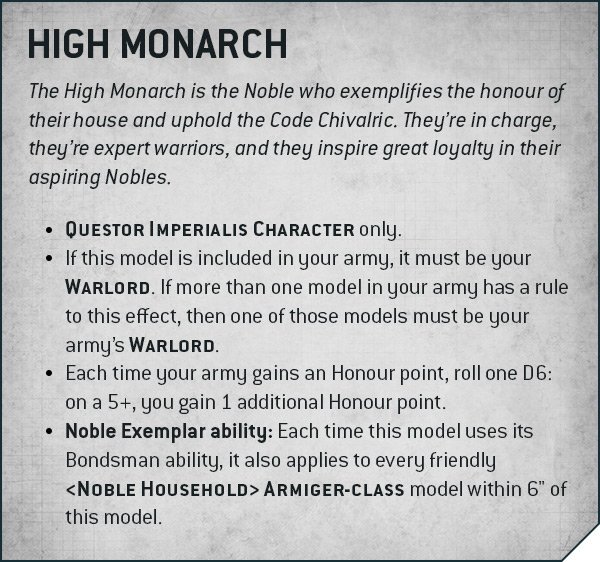
There’s so much depth to these abilities that it’s probably going to take quite a bit of experimentation to work out which are the best, and several look like they potentially unlock powerful strategies, especially on the synergy-heavy Imperialis side. High Monarch is eye-catching there, granting the upgraded Knight the ability to apply their Bondsman effect to every Armiger within 6” rather than just one, potentially unlocking strategies with one big Knight and loads of Armigers, all sporting a buff (it also gives you a chance to increase Honour gain as a static effect). If you’re worried about that Knight getting sniped out, you could maybe go to two big Knights and pick Monarchsward as your second – which makes the chosen Knight a goddamn bodyguard, protecting other CHARACTER Knights as long as they aren’t the closest target to the attacking model. Even if that gets tweaked to be Look Out Sir instead (as this was presumably printed prior to the new Dataslate) that’s still huge, as you can dump defensive abilities on the Monarchsward and force the opponent to go through them first. The Armiger upgrade here of Fight First isn’t bad either, but this is definitely one where you’re paying for the ability.
Another like that is Master of Justice, which gives the chosen Knight a taste of Freeblade-dom by letting them add one of the five custom Martial Traditions on top of your normal one. Adding Hunters of Beasts could make a very powerful answer to other Knight lists, and if Noble Combatants gets fixed to work with big melee weapons that becomes spicy. The Armiger trick here is pretty niche, granting a once per game free Strategic Ploy on one – certainly nothing to sniff at (a free use of A Squire’s Duty for fall back and shoot/charge could be great) but not the centrepiece. The last one to talk about on the Imperialis side is potentially the best of the bunch and right at the other end of the spectrum – Herald is the cheapest of the whole lot, and provides the enormous Armiger buff of a 4+ invulnerable save that applies in melee as well. Given that with a bit of help from a Preceptor you can apply a Bondsman from an Exalted Court model to three Armigers at once, this feels like it could be the foundations of a very strong strategy (and, indeed, features in one of the lists we’ve come up with later).
The Questor Mechanicus have some particularly flashy options for powering up big Knights in Forgemaster and Princeps. Forgemaster is all about the upgrade – as long as the model is wholly within your deployment zone, it gets Damage Reduction. If you want to be as sure as possible that your Castellan isn’t getting alpha-struck off the table, this is your answer, and if you play on tables where lining up good shots from your own deployment is possible, this can do even more. Princeps provides the boost by a different route – allowing the upgraded Knight to use one of their two uses of their Bondsman ability on other Questoris class models instead of Armigers. This isn’t quite as over the top as it sounds, as Bondsman has been carefully worded so that the damage reduction bit only ever applies to Armigers, but this is still strong – a Knight Errant can set up Advance/Charge for a partner, and the Paladin’s re-rolls are very effective. Also intriguing on this side of the fence is Master of Lore, which both grants the upgraded Knight the use of one Preceptor teaching (or an additional one if they’re a Preceptor) and the ability to apply a second Bondsman effect to an Armiger that already has one, allowing you to maximise their killing potential. Mechanicus also gets a mirror of Master of Justice, which could be great with the Honoured Sacristans or Machine Focus Traditions, and also gives a free Battle Tactic rather than Strategic Ploy, which feels slightly more useful.
There’s some extent to which building around these puts quite a few eggs into one basket, but the amount of force multiplication they provide when you’re using them to the full means that these should prove to be a key part of any high end strategies emerging from this book. As mentioned at the start, if you’re playing with the Imperial Knights rather than Chaos the big draw is the combo potential, and Exalted Court is one of the dynamos that drive the book. They definitely aren’t as outright, up front flashy as some of the Chaos Blessing upgrades, and are going to take more experimentation to really nail the correct use of, but do feel very impactful overall.
Knightly Teachings
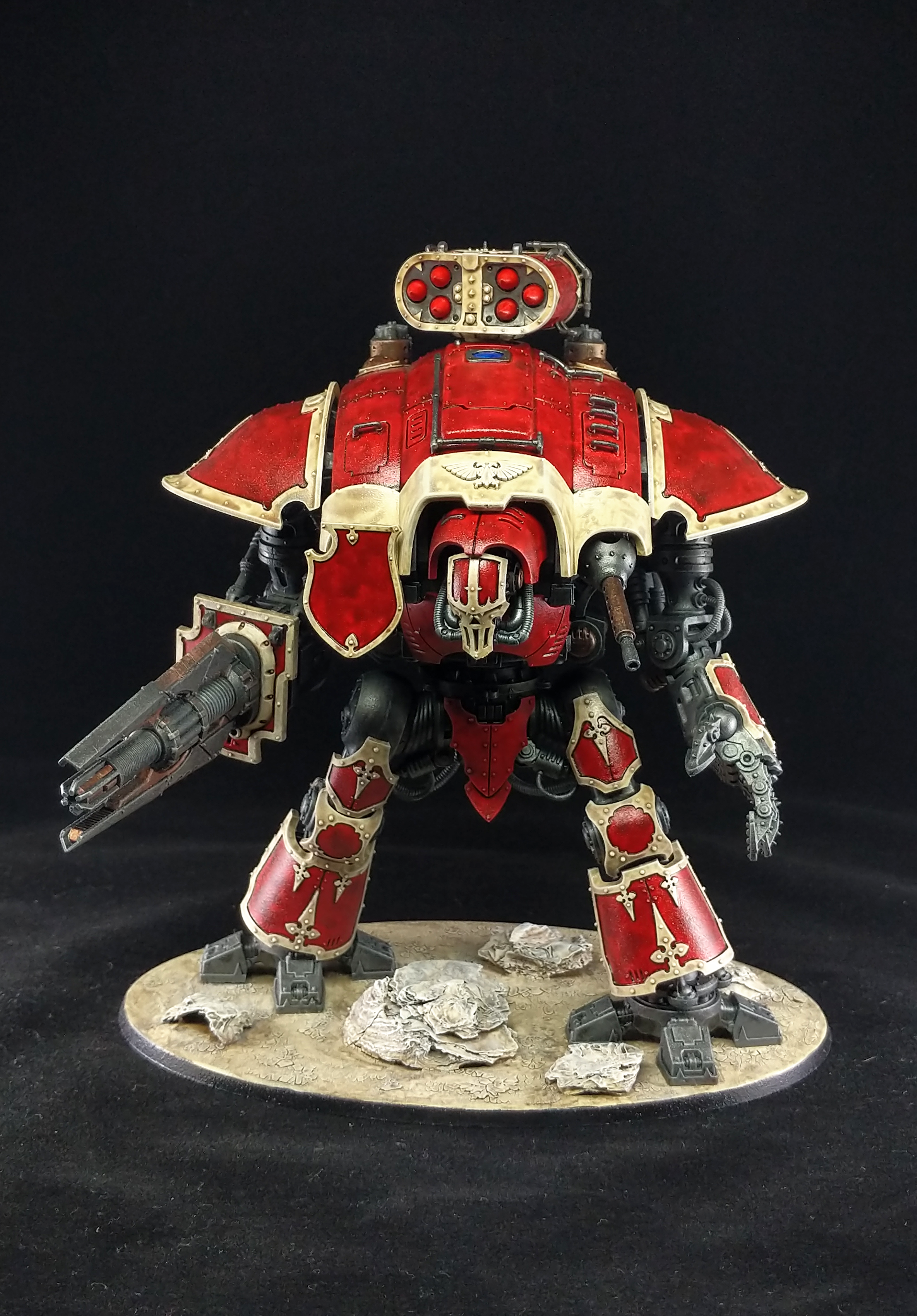
Just in case you hadn’t buffed your Armigers enough, Knightly Teachings provides you with one last route to do so. Preceptors know three of these and can recite two each turn, successfully turning them on on a roll of a 3+ (or 2+ if you’ve taken the Mentor’s Seal), and Questor Mechanicus can also get access to one of these on another Knight with the Master of Lore upgrade. However you’ve gained them, don’t forget that there is also a Stratagem to automatically switch one on at the start of any phase (instead of performing any others for the turn).
Where that’s potentially going to see heavy use is with The Wisdom of Nobility. This lets you pick a nearby Armiger, and when they get chosen for a Bondsman ability you can bounce it onwards so it affects a second Armiger as well. This combines with Exalted Court to allow a Knight to potentially apply both their basic Bondsman effect and whatever Noble Exemplar bonus they have to three Armigers in a single turn, which can be super strong with a powerful boost like the 4+ invulnerable save of Herald. It’s also just flat out useful for maximising the number of Armigers that have Damage Reduction at any one time, and it feels like a particularly compelling use case for the automatic chant Stratagem because you really don’t want to fluff the roll if you’re building a plan around this.
It’s far from the only powerful effect though, and in fact goes great with The Knight’s Faith, which provides a 6+ ignore wounds aura for Armigers, which improves to 5+ when they’re under the effect of a Bondsman effect. Damage Reduction into a 5+ to ignore wounds makes something absolutely nails, and this can allow you to construct very powerful moving castles. The other good aura here is The Virtue of Courage, providing the good clean fun of exploding 6s to hit – an easy thing to throw up if you have no other major plans.
The other three effects are a bit more esoteric. The Folly of Mercy allows an Armiger to Action and Shoot, which is now relevant thanks to a new Secondary Objective, so can be worth having in your “spare” slot if you’re expecting to aim for that. The last two both interact with the Oaths mechanic and they’re…OK. One lets nearby Armigers count your Honour as higher than it is as long as you’ve got at least some active, and the other lets you turn on the Honoured or Virtuous effects of an additional Oath for one model. Both of these sound cool, but run into the problem a lot of things in this book do – quite few rules that interact with the Code Chivalric feel like they were written for a slightly different version of the ability (which I’ll discuss in more detail the end), and end up a bit underpowered as a result. Here, I don’t think you ever take these – there are three excellent choices in the two powerful Auras and Wisdom, and Folly can broaden your objective plan.
Secondary Objectives
Speaking of Secondary Objectives, Knights get some! This is excellent news, as a lack of good Secondaries has been a consistent millstone around the neck of both flavours of Knight since 9th Edition started. They can usually cover Stranglehold and Grind, but are usually left really hoping their opponent gives up 10+ points on a Purge secondary (or Abhor) to not start the game at a disadvantage.
The great news up front is that this section has clearly had a lot of thought put into it – the writers understood those problems, and have addressed them head on. Knights get four secondaries, one each in every non-Warpcraft category, but the really important ones are Duel of Honour in Purge and Renew the Oaths in Shadow Operations, because both of these are secondaries you can max in every game in the categories that don’t overlap with Stranglehold or Grind.
Duel of Honour follows a pretty common template for Secondaries – it designates some of your opponents units as targets, then rewards you depending on how they die. Here, your opponent’s Warlord and two other most expensive units are in the crosshairs, and you get five points if for each one your warlord kills in melee, four if any other Knight does (or the opponent leaves them off the table like a coward), and three if they die in any other manner. You get a bonus point at the end if the enemy Warlord died, but lose one for each target that survived. This is good clean fun – you probably won’t outright max it very often, but you can also pretty comfortably rack up 8-12pts just by playing the game exactly like you were already planning to, and a good shot at 13 or 14 if the game is going your way and you want to climb up the leaderboard. Great stuff, especially for Imperialis armies.
Renew the Oaths covers your other problem category, providing Knights with an Action secondary of your very own. The ask here is simple – perform an Action running from the end of movement to the end of your turn within 6” of the centre of the Battlefield (with no requirement that the enemy be absent) and get 3VP each time, +1 if the model doing so was TITANIC and +1 if they were a CHARACTER. You even gain an extra Honour point on a 4+ each time you perform it! The design here is cool, because on paper this is one of the easiest Action Secondaries to max out there – but because you generally have so few models as Knights, taking one out for a whole turn hits you harder, a good bit of tension. My feeling is that this still probably ends up very good – every list I’ve built with this book has ended up heavy on Armigers, which should be able to comfortably push this to 9pts over the first few turns, and the fact that at the end of the game if you need to one of your big Knights can just slam this button for 5VP on your last turn feels very good. Probably even better than Duel from a pure scoring perspective, but asking a bit more of you, so there’s some judgement between them.
The other one here that will see use is Yield No Ground in Battlefield Supremacy, returning from Chapter Approved as a better Stranglehold. While Knights can very much cover Stranglehold, and normally want to be using their faction pick on one of the two above, on Recover the Relics specifically (and any future six objective mission) the fact that this only asks you for half or more of the objectives rather than more than half makes it much more reliable – consistently being on four objectives for enough of the game to score highly on Strangle is a risky commitment to make. I like the fact that this exists, because recognising the issues Knights have with six objective maps is another pretty nuanced piece of design.
The objective I don’t like is Honour of the House, which is in No Mercy, No Respite and is horrible. It rewards you for each Battle Round you finish on more Honour than you started, and then has an end-game bonus or penalty depending on where you ended up, but the difficulty is pitched way too high – if you pull this off perfectly you only get thirteen victory points, and your score will likely be pretty mediocre in a close game (especially if you took Lay Low the Tyrants). Don’t take this – pick Grind instead (and even if your opponent is on Knights too, go Titanslayer/Strangle/Renew over this).
The good thing is that Honour being garbage doesn’t matter at all – the other three objectives here do a huge amount to even the Secondary playing field between Knights and everyone else, and should be a big contributor to the army’s success.
Freeblade Lance

An actual first here – an Army of Renown in a Codex. The Freeblade Lance was first introduced in the Book of Rust, and has been a surprisingly impactful part of Imperial Knight play since. Mostly that’s been because Freeblades could stack up far more ways of making a big Knight ObSec than any other loyalist build via Traits and Burdens, vital for playing the mission in 9th. The old mechanics flat out wouldn’t have worked with the new way that Freeblades operate, so one might have expected the rules to go the way of the Crusher Stampede, but instead they’ve been completely revamped and included in the book – fantastic news for fans of this particularly cool army. That said, Knights have a lot more access to ObSec now, so that niche doesn’t need filling, so is the new version worth it?
Things look promising – there’s enough going on here that it’s certainly worth trying out, and could prove powerful enough to be a valid third option alongside the two Questor Allegiances. Playing the Lance requires you (unsurprisingly) to make every unit in your army a Freeblade, which cuts you off from any of the normal Household Traditions or Questor Allegiance Oaths, but you get a lot in exchange (in addition to each Freeblade picking a Martial Tradition, and with fourteen options you shouldn’t ever run out).
Forming the Lance gets you:
- An additional Tradition (Indomitable Heroes) that applies to every unit in your army, which is very clearly pitched as the equivalent of the Allegiance Oaths (as it combines parts of the two Questor ones).
- The Legendary Knight rule, allowing your Lance CHARACTERS to pick Exalted Court abilities (changing any relevant keywords to FREEBLADE).
- Additional stratagems and a new Warlord Trait and Relic to pick from
- The implicit ability to mix Imperialis and Mechanicus keywords in your army, making use of both sets of relics and stratagems. This works because Freeblade units are exempted from the Nachmund rule that all selections for a given Keyword have to be the same, and because those two Keywords do not have the standard boilerplate in the Datasheets section of the book about not mixing them in a single detachment (because most of the time HOUSEHOLD will compel that anyway, and that does have the standard restriction).
All of this is pretty good. Indomitable Heroes gives you two things – a wound back at the start of each Command Phase, and the ability to ignore penalties to Advance or Charge rolls. Perhaps a bit weaker overall than either of the main Oaths, but certainly nice to have. Taking Exalted Court stuff is also fantastic – as mentioned, these feel like a vital engine for the army, so not being cut off from them entirely is critical. You also, if you’re feeling spicy, have the option to take a mixture of Imperialis and Mechanicus choices across your list, which is probably most likely to come into play with Master of Lore and Herald – getting to double stack Bondsman effects on potentially a trio of Armigers (remembering that Master of Lore gives one Preceptor Teaching as well) that also gain a 4++ seems excellent.
Many of the extra choices are good too. The Warlord trait is essentially the one that the Lance used to get with new wording, allowing the Warlord to gain the Martial Tradition of a named house in addition to its Freeblade one (picking from the relevant options for its Questor Allegiance). Mortan, Taranis and Raven all look like decent picks here, and this is a nice tool to have access to (and even just adding an extra attack from Griffith is fine if you’ve already used Knight Seneschal). The relic is just a super-charged Reaper Chainsword, but it’s a pretty good super-charged Reaper Chainsword, notably out-performing Ravager if there are lots of T5 targets that need chainsawing (though falling behind a bit if you’re stacking lots of bonus attacks on a single model).
Finally, you get four Stratagems, all of which are useful. Brothers and SIsters in Burdens has slightly odd wording that may need tidying up, but it appears to give you an aura around one of your CHARACTERS that allows models within it to still use the Honoured effect of your Oaths if you’ve become Dishonoured. This is massive – you would absolutely pay 1CP for a large aura of +1 to hit in melee or the Martial Pride re-roll, and that’s what this will be when things are otherwise going wrong for you. This does need an FAQ to clear up the wording, but we’re pretty sure on our interpretation above, and it’s powerful assuming we’re correct.
Also playing with Oaths in a great way is Deeds of Legend. When one of your models destroys an enemy VEHICLE, MONSTER or CHARACTER, you can pick one of the eight Honoured or Virtuous abilities for your model to gain permanently till the end of the battle. A cursory glance at the effect list indicates that this can, in fact, be permanent ObSec for a big Knight via Duty and Honour so psyche – extra ObSec is still a Freeblade Lance gimmick. This also only costs you 1CP, so feels like it will often be good when available. Last in the on-table abilities is Strength From Exile, giving a model re-roll 1s to hit and wound if they’re more than 12” from any of your other models. This is a huge force multiplier when available, and can be fantastic on both an Armiger that’s ranged far away from the pack, or your last big Knight when you’re trying to squeeze a final few points from a nailbiter of a game.
The last Stratagem is another returning classic, letting you take a second Relic on one model for 2CP. This rules – sticking both Sanctuary and a relic melee weapon on the same model is your default plan here, but stacking the Banner of Macharius Triumphant with defences is good too, and there’s probably something extremely stupid you can do with the Heart of Ion.
So where does this all end up? Great, honestly – there’s enough to put this on par with your other army construction options. Your Questor Allegiance equivalent is slightly weaker, and your assembly of Traditions will be a bit less focused than an army built around a Household, but you get the payoff of a more powerful set of Stratagems than any single house and some real flexibility around Relics and Exalted Court options. It definitely feels like it’s worth testing alongside other builds, which suggests a pretty well-pitched power level.
The Units
This section is, obviously, going to be much shorter than it normally would be in one of these reviews, as Knights have a pretty short list of units, and five of them differ only in their combination of weapons and which Bondsman ability they get (which we already covered earlier). With that in mind, we’ll first talk about what Knights look like in general, then have a quick look at any specific nuances that arise beyond that.
General
Knights are all storied warriors with a good BS/WS of 3+ and 4A (with a few exceptions), and have three basic defensive statlines, corresponding to each of the three classes:
- The Armiger is your light Knight – you get up to three in a unit, which have to deploy within 6” of one another but then independently from there. They’re equivalent to the mid-tier walkers of other factions, with T7 and 12W. They’re also nippy with a 12” movement.
- Questoris Class Knights are the classic Lord of War, sporting 24W and T8. They move 10”.
- Dominus Class Knights are heavy duty engines of war, keeping T8 and going up to 28W and a 2+ save. They’re a bit slower at 8”, and also only get WS4+ due to being a bit cumbersome.
Knight experts will notice that movement has dropped a bit across the board, going down 2” on all classes, and that definitely bites from our testing. The other general nerf to knights compared to the previous edition is that the basic titanic feet weapon all TITANIC Knights have no longer multiplies your attacks, so the Knight Crusader and the Dominus Knights are a lot less scary in combat than they used to be.
To compensate for this, various other weapons have received significant boosts, especially the melee ones. Reaper chainswords and thunderstrike gauntlets both now get a sweep option in addition to their mighty strike profiles, with Reapers essentially acting as the old titanic feet (but with better AP) and thunderstrikes only doubling your attacks, but hitting at S10 and D3, so effective if you’re up against damage reduction or T5 units. Thunderstrikes also no longer reduce your hit rolls, so both melee options end up feeling valid, and you potentially want to mix it up a bit across your list. In general, you end up vastly more incentivised to take melee/gun Knights now than you used to be. The Armiger Warglaive also gets improved AP on its chaincleaver, making it even nastier than it was before.
Various guns have also seen tuneups, particularly the thermal cannon, rapid fire battle cannon, plasma decimator and rapid-fire battle cannon. Thermal cannons get a better shot count (2d3 rather than d6, which rules) and a starting damage of d6+2, improving to d6+4 at half range. Truly terrifying for enemy vehicles, and even more of a reason why the Errant is one of the biggest winners in the book. The rapid fire battle cannon only gets one upgrade but it’s a goody – flat damage three rather than d3. Also very strong, particularly when dealing with damage reduction. The plasma decimator is also on the damage boost train, getting the same upgrade most tank-based plasma has in 9th – base damage 2, damage 3 on overcharge. It’s also higher strength and AP than it used to be – functionally, the baseline is now what Cawl’s Wrath used to be. The only downside is that you take two Mortals for each 1 to hit on the overcharge mode, but you’re absolutely happy to pay this price. Finally, armiger autocannons get an extremely welcome boost to AP-2, helping them keep pace with some of the defences out there.
With those upgrades applied, there are a few things that fall behind a little simply by staying still. The avenger gatling cannon remains identical to 8th Edition, and honestly now looks like an underwhelming pick – there’s too much damage reduction out there for it to be the all-rounder it once was, and the Warden that carries it is now priced slightly higher than the Paladin, who is probably better overall. Top guns also look a little underwhelming – ironstorm missiles suffer badly from the new Indirect rules, and all the choices here are pretty expensive. You might still want to buy a stormspear pod on a Knight to upgrade to Judgement, but elsewhere the leftover points you would previously have spent on these might be better used for Exalted Court choices.
Lord of War
As promised, this will be pretty quick.
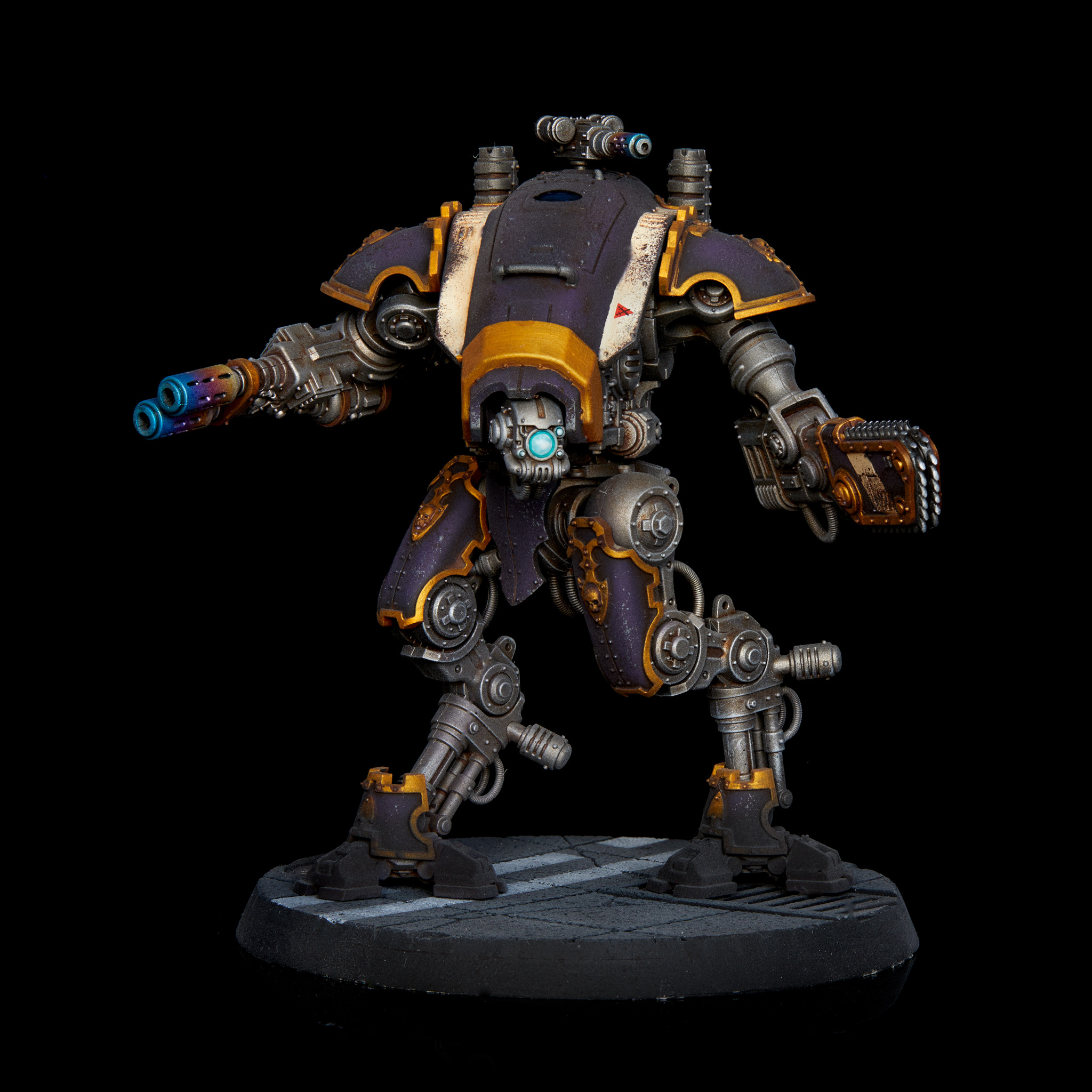
We start with two flavours of Armigers – shooty Helverins with two autocannons, and melee Warglaives with a thermal spear and chain cleaver. Warglaives are 10pts cheaper and good for applying pressure to the opponent – they love getting damage reduction from Bondsman and getting stuck in to the enemy. This means you’re probably taking more of them, but the boost to Helverin AP (and the need to have something to sit on home objectives) means that a few of those aren’t bad to have either.
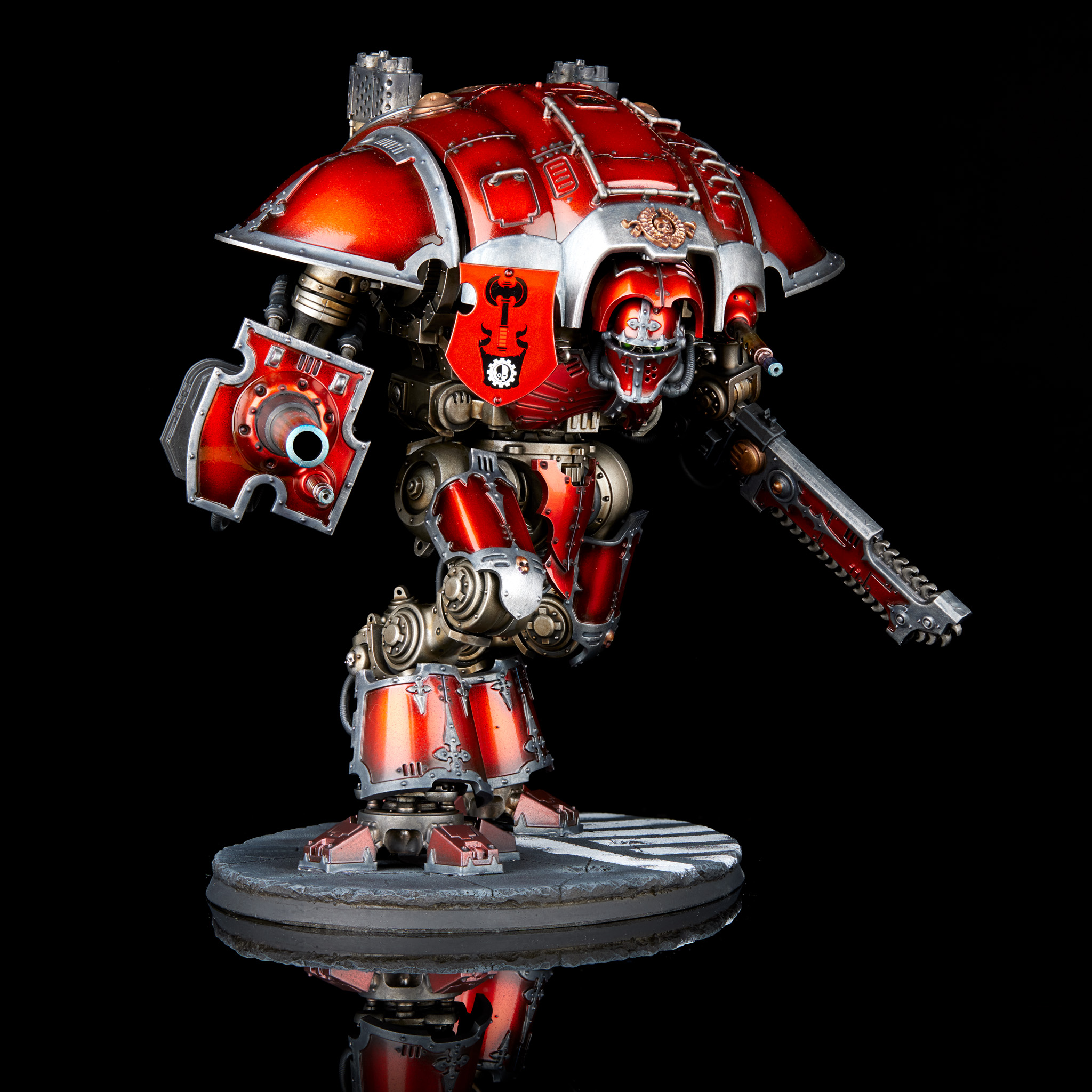
Moving on to the five “regular” Questoris class Knights, the standouts feel like the Errant, Gallant and Paladin. The Errant’s Bondsman ability is the biggest game changer of the bunch – giving Armigers Advance/Charge massively extends your threat range, especially in concert with a 9” Advance from Full Tilt, and given the thermal cannon is also great, you’ll see these in a lot of lists. Paladins are very good all-rounders – the rapid-fire battle cannon is signifcantly improved by its extra damage, and the Bondsman effect of RR1s to hit and wound is a better force multiplier than any of the other options. Finally, Gallants are still your best choice for a wrecking ball – in exchange for not having any big guns, they’re cheaper, faster and better in a fight than all other Knights, getting an extra 2” of move, WS2+ and 5A. There is absolutely a role for these to play in some lists, especially very aggressive Imperialis ones. Wardens and Crusaders, finally, are both fine but pay for the sins of 8th Edition – the avenger gatling cannon isn’t as good as it was on either, and titanic feet not being a serious weapon any more really hurts the Crusader, who is still way more expensive than other Knights.
Off to one side in the Questoris section you have the Preceptor, with a unique weapon (the las-impulsor, notably sporting improved range and flat damage 4 on its “big” profile) and Knightly Teachings instead of a Bondsman effect. These are fine – they’re decently priced, and the Teachings can have a real impact. One Preceptor and loads of Armigers seems like a plausible build, and teaming one up with an Exalted Court model you want to multiply the Bondsman ability of is strong too.
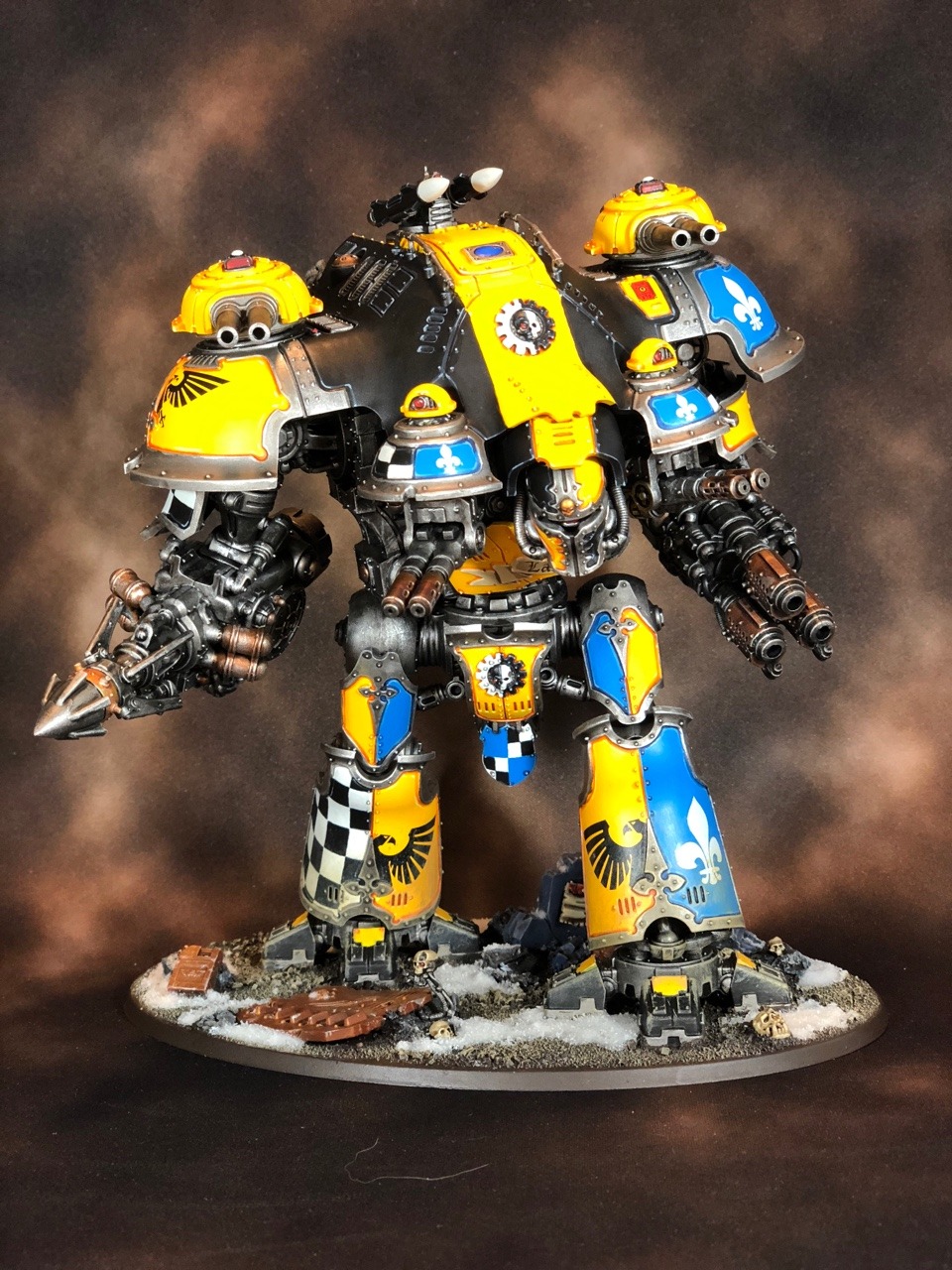
Next up, your two Dominus options. The Castellan is still the master of the dark arts of the gun, packing a lethal plasma decimator and volcano lance, and plenty of other weapons besides. The lance has fewer shots than it used to, but they’re even deadlier if they hit at d6+8 damage, and in combination with the souped-up plasma decimator this model is an absolute nightmare for your opponent’s heavier units. Being a bit less able to defend itself in melee does somewhat pigeonhole it into a role of blasting away from fairly close to home, but it’s pretty good in that role. If that sounds like coward talk, and you want to really test what that 2+ save can do, the Valiant is your other option here, with a powerful flamer on one arm and the lethal thundercoil harpoon on the other. The Valiant is deadly up close, but hasn’t really changed from 8th other than the 2+ save, and the loss of melee capability really does bite on it. You might have more luck with one over in Chaos Knights, where some of the defensive upgrades can keep these operational in the face of the opponent for a prolonged period, causing problems on purpose. In Imperial Knights, the Castellan in some of the Mechanicus houses feels like it has the most play of the big ones.
Finally, one more unit – Canis Rex, a legendary Freeblade who brings the teachings of a Preceptor (which he gets a special rule to apply to any Armiger, even though he’s FREEBLADE rather than HOUSEHOLD), a massively boosted offensive statline, a built-in relic thunderstrike gauntlet, exploding 6s and a re-roll per battle round. Also, when he dies, his pilot Sir Hektur gets set up on the Battlefield and gets to wander around till squashed, which is a cool bonus (and could actually be great for finishing off Renew the Oaths, as he still qualifies for 4VP in this state and isn’t doing much else). Having been essentially a non-factor in 8th, Canis Rex is honestly pretty pushed for the price tag in 9th, and could see some experimentation, especially if the Freeblade Lance takes off, or if taking a solo-Freeblade in other Imperium lists is popular. That last one might sound surprising given you’d be getting nothing from his Teachings in that situation, but because he effectively has a Warlord Trait and Relic built into his statline (which you won’t normally get when bringing a solo-Freeblade), he may well still end up as a better choice than other options in this role.
Our Thoughts
How They’ll Play
Playing Knights is all about overwhelming the enemy. Most armies present a mix of defensive and offensive profiles, which savvy opponents will try to exploit by deploying their units so they’re facing favourable targets. Knights don’t really allow this – every unit in the army is a durable vehicle, and most are capable damage dealers both at range and up close. That does two things – saturates the opponent’s anti-tank weaponry with targets, and puts them on a serious clock to inflict damage on your army before they’re overrun.
The updated version of Imperial Knights looks like it leans into that plan harder than ever. Being able to give Armigers damage reduction means that the gap between their durability and that of the big Knights is smaller than it used to be, making it harder for opponents to try and pick them off first to at least thin your ranks. Their broad range of stratagems means they’re very adaptable even when rampaging solo through the enemy lines, and adding Imperialis Households and abilities can make them very speedy too. You now have the flexibility to send Armigers ranging out as a powerful advance guard or keep them bundled up with your big Knights for maximum buff power, letting you adapt to what’s happening on the battlefield.
Buffs are a big part of this book in general – it feels like if your army list doesn’t contain at least one plan for creating super Warglaives and firing them at the opponent you’re probably not squeezing the full power out of it. You’re going to be hitting the sweet spot with this army when it really feels like a powerful band of heroes rampaging through the enemy while powering one another up.
Hot Takes
Wings
This book joins the ranks of those that grew on me over the course of writing about it, and I’m going to be very interested in how well it ends up performing in practice. There’s a surprising amount of complexity and depth here for a book with so few Datasheets, and my feeling is that it’s going to turn out to be more powerful than most people initially give it credit for – especially since there’s more obvious power in the Chaos book it’s releasing alongside.
So, things I like. First up, this book and the Chaos book feel genuinely distinct, which is a big achievement design-wise. Bondsman and Exalted Court create some unique incentives when building lists and playing the army on the table that are just different from anything in the Chaos book, and I think that’s vital for ensuring both armies have a place in the game’s ecosystem, especially in the competitive scene. Because of the model overlap, if both armies are just playing the same high-efficiency game plan, competitive play will gravitate toward whichever happens to do it best, but this time around both books can do some things that the other just can’t, which is excellent. That’s not easy to pull off, so deserves serious praise.
I also like the level of combo potential in general – there’s a lot to tinker with here, and a pretty broad set of avenues to explore that could turn out to be seriously viable. I did find I was having to flip back and forth between different pages of the book to keep track of what was possible, maybe a little too much, but that’s mostly because I’m trying to hyper-optimise rather than because it felt like there were trap options. If you made me put down £5 on what build here turns out best I’d call it for aggressive Griffith, but I think Freeblades (big points on these, the Lance’s power level feels well pitched) and some of the Mechanicus houses have angles too. Whichever build does end up performing will be helped by the Secondary Objectives, which I think are a particularly well-designed set and really address some army challenges.
Inevitably, there are always some things in books I like a bit less, and here that’s the Code Chivalric. To be extremely clear, I don’t think that’s because it’s bad – it’s a significant boost to the power of Knights, sufficient that I’m sure the slight clunkiness will be forgiven by the playerbase. To my eyes though, despite the power, it just feels a bit unfinished – I don’t think you’re motivated enough to really strive for Virtuous status, and lots of the abilities that key off it seem to assume that the bonuses are universally model-based, where in fact two of the eight (including one of the most important ones) operate at the army level. It still mostly works and no one’s going to hate a mechanic where they get to build up a big pile of points for being cool, but there’s a definite feel of some fairly late stage changes to the mechanic that weren’t fully cascaded across the whole book.
My only other concern with the book is whether a high-synergy, high-combo army partially built around models that can’t be Obscured will consistently hold up in 9th Edition. You’re very motivated to bring at least one Questoris Class Knight that can apply multiple Bondsman effects in a single turn, but sometimes your opponent is going to go first and just kill it. I would say that in general there are currently relatively few armies out there that can pull this off, but current Tau trends appear to be towards running a Stormsurge and 3-4 Hammerheads, which is a capital-C Concern. You do have some options to help here – Monarchsward can maybe force that alpha strike onto a more expendable Gallant, and using a Preceptor as part of your Bondsman multiplication plan can make it more durable if one of your big Knights goes away. Building a skewed army has to come with some risk and this is what you deal with as Imperial Knights – but it does feel like Chaos are maybe better set up to handle that problem. On that note, it would also have been nice for Imperials to maybe get one more unique datasheet – with the new release wave Chaos now functionally have a lot more unit choices, and the chaincannon war dog in particular is a real source of envy.
Gripes are eternal, however, and I will circle back to the fact that I like this book, and liked it more the longer I spent digging into it. If you put me on the spot, I think the Chaos Knight book is a bit more likely to make the initial metagame waves, but a lot of that is tied up in Blessing of the Dark Master being overpushed to a dangerous degree, and I still think there’s a chance that some sort of Armiger buff build from this book ends up being more broadly capable.
Will Knights overcome the general challenges of running them in 9th? We’ll see – the Secondaries being good helps massively, and Bondsman‘s damage reduction is the real deal. I think this book does a good job overall, and I would definitely encourage anyone who’s disappointed on a first read-through (especially coming straight from Chaos Knights) to give it a second pass and really dig in to how it all comes together
Army Lists
Two from me here – one Imperialis, one Mechanicus. We’ll start with Imperialis, because as I haven’t been able to shut up about, I think House Griffith potentially gives the strongest builds in this book.
House Griffith YOLO Mode
House Griffith Super-Heavy Detachment
Oaths: Defend the Realm, Refuse No Challenge
LOW: Knight Errant, Exalted Court: Herald, Warlord: Ion Bulwark, Helm Dominatus – 445pts
LOW: Knight Preceptor, Knight Baron: Knight Seneschal, Heirlooms of the House: Mentor’s Seal – 420pts
Teachings (3+1 for seal): The Wisdom of Nobility, The Knight’s Faith, The Warrior’s Hope, The Folly of Mercy
LOW: Knight Gallant, Knight Baron: Master of the Joust, Heirlooms of the House: Sanctuary – 400pts
LOW: 2x Warglaives, meltaguns – 300pts
LOW: 3x Warglaives, stubbers – 435pts
2000pts, 8CP
This list is all about going very, very fast. Between Exalted Court and The Wisdom of Nobility, three Armigers can all be souped up to a 4+ invulnerable save and Advance/Charge at once, and the Gallant is in permanent Advance/Charge mode as well. That’s an enormous punch for any opposing army to try and absorb, and using the Helm Dominatus on the Errant also allows whichever Armiger is going to range furthest ahead to be locked-in to the Bondsman effect, staying in hyper mode for ever more. The second wave of the Preceptor, Errant and remaining Armigers form a powerful force to claim the mid board, and are perfectly happy getting stuck in as well if the situation calls for it.
Grumpy House Taranis
House Taranis Super Heavy Detachment
Oaths: Defend the Realm, Lay Low the Tyrants
LOW: Knight Castellan, 2x cannons, 2x missile, Warlord: Knight of Mars, Revered Paragon: Revered Knight, Exalted Court: Forge Master – 655pts
LOW: Knight Errant, Knight Baron: Knight Seneschal, Sanctuary, Exalted Court: Master Tactician: Machine Focus – 455pts
LOW: 2x Warglaives, stubbers – 290pts
LOW: 2x Warglaives, stubbers – 290pts
LOW: 2x Helverins, stubbers, one with Heirlooms of the House: Bastard’s Helm – 310pts
2000pts, 8CP
This list aims for a bit more of a mix of shooting/melee supremacy. The Castellan with Forge Master probably isn’t dying out of the gate, and is a terrifying force against anything visible. Knight of Mars sets up the hilarious Calculated Targeting combo, and also just generally provides a clutch automatic save against anything smaller than a railgun Joining the Castellan in providing dakka are some Helverins, one of which is sporting the Bastard’s Helm. Two of these with +1 to wound is no joke, and might force the opponent to make some tricky choices as to what they’re trying to deal with first. The rest of the build is an Errant shepherding some Warglaives forward once more, just with more of a melee build on the Errant themselves as there’s no Gallant to be the first big push.
Wrap Up
That covers the Imperial Knights, but their twisted nemeses have a new book (and some new models) as well. Make sure to check out our Chaos Knights review so that you know what you’re up against, and check back in on Tuesday for the Crusade review.
